

guided tours

Tour 1: 3 Day + Kgalagadi Transfrontier Park Tour
Tour the Kalahari Desert and explore the Kgalagadi Transfrontier Park. See the desert adapted wildlife species in their natural habitat. Malaria free area. Accommodation: Chalet or camping Tour options: Guided tour

Tour 2: 5 Day Kgalagadi Camping Tour (Botswana side)
Experience the real Kalahari on a camping safari on the Botswana side of Kgalagadi Transfrontier Park, camping in the wild in unfenced campsites with very basic facilities. Malaria free area Accommodation: Camping only Tour options: Guided tour

Tour 3: 4 Day+ Kgalagadi Wilderness Camps Tour
Tour the Kgalagadi Transfrontier Park and overnight in small, unfenced exclusive Wilderness Camps, for those who prefers more privacy and exclusivity. Malaria free area Accommodation: Chalet only Tour options: Guided tour

Tour 04A: 3 Day+ Kgalagadi – Xaus Lodge Exclusive Tour
Accommodation in the Kgalagadi Transfrontier Park is in the exclusive Xaus Lodge, situated in the dunes overlooking a pan. Game drives in open vehicles. Malaria free area Accommodation: Chalet only Tour options: Guided tour

Tour 04B: 5 Day+ Kgalagadi – Tashebube Lodges Exclusive Tour
Experience the Kgalagadi Transfrontier Park and overnight in the exclusive Rooiputs and Polentswa Tashebube Lodges on the Botswana side of the park. Game drives in open vehicles. Malaria free area Accommodation: Chalet only Tour options: Guided tour

Tour 04C: 7 Day+ Kgalagadi – Xaus & Tashebube Lodges Exclusive Tour
Tour the Kgalagadi Transfrontier Park and overnight in the exclusive Xaus Lodge and Tashebube Lodges on the Botswana side of the park. Game drives in open vehicles. Malaria free area Accommodation: Chalet only Tour options: Guided tour

Tour 5: 5 Day Kgalagadi Birding Tour
Kgalagadi Transfrontier Park is one of the more popular birding destinations in Southern Africa and one of the best places to see raptors. The tour can be extended to Augrabies Falls National Park. Malaria free area Accommodation: Chalet or camping Tour options: Guided tour

Tour 6: 5 Day Kgalagadi – Augrabies Falls National Park Tour
Tour the Kalahari Desert including Kgalagadi Transfrontier Park, Orange River Valley to Augrabies Falls National Park. A great combination of the wildlife and a variety of desert scenery. Malaria free area Accommodation: Chalet or camping Tour options: Guided tour

Tour 7: 7 Day Kgalagadi – Augrabies – Witsand Nature Reserve Tour
A comprehensive tour of the natural highlights of the Kgalagadi Transfrontier Park, Orange River Valley, Augrabies Falls National Park and Witsand Nature Reserve. Malaria free area Accommodation: Chalet or camping Tour options: Guided tour

Tour 8: 9 Day Kgalagadi – Mokala National Park Wildlife Tour
Tour the prime wildlife parks in the Northern Cape Province. Experience wildlife ranging from the desert adapted species of Kgalagadi Transfrontier Park Reserve to the endangered species of Mokala National Park. Malaria free area Accommodation: Chalet or camping Tour options: Guided tour

Tour 9: 8 Day Kgalagadi – Ai-Ais/Richtersveld Transfrontier Park Tour
This desert tour covers the wildlife and landscapes of the Kgalagadi and the Namibian and South African sections of the unique Richtersveld Mountain Desert. Malaria free area Accommodation: Chalet/Guest House or camping Tour options: Guided 4×4 tour, Guided 4×4 self-drive convoy tour

Tour 10: 6 Day Kgalagadi – Nossob Eco 4×4 Trail
Sandy Trail. This 4×4 tour takes place in the South African part of the Kgalagadi Transfrontier Park. The Trail runs parallel with the Nossob River, through the duneveld of the Kalahari Desert. Malaria free area Accommodation: Camping only Tour options: Guided 4×4 tour, Guided 4×4 self-drive convoy tour

Tour 11: 6 Day Kgalagadi – Polentswa Wilderness 4×4 Trail
Sandy Trail. The circular Polentswa Wilderness 4×4 Trail runs through the Botswana part of the Kgalagadi Transfrontier Park and is a true Kalahari Wilderness experience with absolute privacy. Malaria free area Accommodation: Camping only Tour options: Guided 4×4 self-drive convoy tour

Tour 12: 7 Day Kgalagadi – Mabuasehube 4×4 Tour
Sandy Trail. The Mabuasehube 4×4 Tour includes the wilderness areas of Mabuasehube on the Botswana side and the Nossob River Valley on South African side of the Kgalagadi Transfrontier Park. Malaria free area Accommodation: Camping only Tour options: Guided 4×4 tour, Guided 4×4 self-drive convoy tour

Tour 13: 10 Day Kgalagadi – Mabuasehube – Kaa Game Viewing Trail 4×4 Tour
Sandy Trail: This tour is a combination of the Mabuasehube section & Kaa 4×4 Trails in the Botswana side and the Nossob River Valley on South African side of the Kgalagadi Transfrontier Park. Malaria free area Accommodation: Camping only Tour options: Guided 4×4 tour, Guided 4×4 self-drive convoy tour

Tour 14: 9 Day Kgalagadi – Mabuasehube – Kaa Concession Area 4×4 Tour
Sandy Trail: This tour is a combination of the Mabuasehube, adjacent Kaa Concession Wilderness area in Botswana and the Nossob River Valley on South African side of the Kgalagadi Transfrontier Park. Malaria free area Accommodation: Camping only Tour options: Guided 4×4 tour, Guided 4×4 self-drive convoy tour

Tour 59A: 8 Day Kalahari Lion & Other Predators Chalet Tour
The emphasis is on finding the magnificent Kalahari Lions and other predators while staying in the comfort of chalet accommodation. Malaria free area Accommodation: Chalet Tour options: Guided tour

Tour 59B: 8 Day Kalahari Lion & Other Predators Camping Tour
The emphasis is on finding the magnificent Kalahari Lions and other predators while camping. Facilities vary from good to very basic in wilderness campsites. Accommodation: Camping Tour options: Guided tour, Guided 4×4 tour, Guided 4×4 self-drive convoy tour

Tour 60: 4 Day+ Kalahari Raptor Tour
One of the best places to see raptors in Southern Africa is Kgalagadi Transfrontier Park, with more than 20 species recorded Accommodation: Chalet or Camping Tour options: Guided Tour

Tour 61: 4 Day Kalahari Meerkat (Suricate)Tour
On this tour the emphasis is on finding meerkat (suricate) in their natural habitat in the South African side of the Kgalagadi Transfrontier Park. Malaria free area Accommodation: Chalet or Camping Tour options: Guided Tour

Tour 62: 10 Day Kalahari Meerkat (Suricate) 4×4 Tour
This tour offers clients the opportunity to see meerkat in wilderness areas in Botswana and on the South African side of the Kgalagadi Transfrontier Park in the Kalahari. Malaria free area Accommodation: Camping Tour options: Guided 4×4 Tour; Guided 4×4 self-drive convoy tour
Welcome Guided Tours Cammspannen 4x4
NATIONAL PARKS & RESERVES
South African & Swaziland Namibia Botswana Zimbabwe
KALAHARI SAFARI TOURS & TRAVEL Upington 8801
TEL/FAX: + 27 (0) 54 3380375 CELL: + 27 (0) 82 4935041

Kgalagadi Transfrontier National Park
Sub regions inside, broader region.
Kgalagadi Transfrontier National Park is a unique conservation area that straddles the border between South Africa and Botswana. It is the first transfrontier park in Africa and is home to a wide variety of wildlife, including the Kalahari lion, cheetah, leopard, brown hyena, and many species of antelope. The park also offers visitors the opportunity to experience the Kalahari Desert in its natural state, with its vast open spaces, red sand.
The best time to visit Kgalagadi Transfrontier National Park is during the dry season, which runs from May to October. During this time, the temperatures are milder and the wildlife is more active.
May to September
- Warm, mild weather
- May is a great month for wildlife viewing
October to April
- The landscape is gorgeous and spring flowers appear after the first rains
- End of the Wet season is the best time for wildlife viewing
- The best time for birding because migrant species are present
.webp)
May 10, 2024
Fabulous and efficient service by Shann…
Fabulous and efficient service by Shann Shaw, highly recommend her services! Made the process simple and stress-free.
May 9, 2024
Great experience- very well organised…
Great experience- very well organised and trustworthy. 5 Stars
professional service
professional, courteous and prompt service from Heleen at all times.
Patient help and guidance to find just…
Patient help and guidance to find just what I wanted.
May 8, 2024
Pascal is a travel angel! Highly recommend him.
We started planning for our safari trip contacting a bunch of different travel advisors but Pascal's service truly stood out to us as the best in the industry. He took care of planning everything from start to finish for our very last minute honeymoon trip (literally a month out and during the busiest safari season). He is extremely meticulous and very responsive to our 100 questions. He shared first hand experiences at each of the different lodges, personal pictures and gave us solid recommendations within our budget. He hopped on a call with us initially to explain all the differences to us first time safari goers, and continued to be very flexible and patient with us as we couldn't decide! We are very excited for our trip and cannot thank Pascal enough for being our first interaction on our upcoming trip.
Tanya was very efficient with helping…
Tanya was very efficient with helping ME get the correct booking.
Pascal was so responsive
Pascal was so responsive, informative and delightful!! I am grateful for Pascal’s expertise!! Many thanks!! 🙏🏽🦋☮️
May 7, 2024
Very helpful even with ever changing trip!
Anja was very helpful in getting our tour booked for our group. With date changes, time changes, even up to the last minute flight changes, she was on top of things! We will use Safari.com in the future for our Kenya safari trips.
Wonderful experience with Safari.com
Wonderful experience with Safari.com. My Safari Agent, Dolan, has 20+ years of experience in booking a memorable safari. He guided me in picking the right lodging and safari within my budget. He offered several options and answered all my questions. His response time was fast, regardless of the international time difference, and we were able to make quick decisions. Highly recommend.
- Affiliation
- Cape Town City Tour
- Cape Point Tour
- Jewish History
- Kirstenbosch Botanical Garden
- Robben Island
- Wine Routes
Whale Watching
- Anglo Boer War around Gauteng
- Battlefield trip – Magaliesburg
- Bill Harrop’s Original Balloon Safaris
- Constitutional Hill
- Cullinan Diamond Mine
- De Wildt Cheetah Centre
- Elephant Sanctuary
- Lesedi Cultural Village
- Malapa Fossil Site and Gladysvale
- Pilanesberg
- Johannesburg Jewish history
- Pretoria city tour
- Soweto Tour
- 3 day Kruger Classic Safari
- 4 day Kruger Walking Safaris
- 4 day Kruger Park & Panorama Route
Kgalagadi Transfrontier Park
- Game Parks of Northern KwaZulu Natal
- Best of Cape Town
- Garden Route Tour – 4 days
- 6 National Parks of the Cape
- S.A. War 1898-1902. The Anglo Boer War
- Namaqualand Wildflowers
- The Overberg and Whales
- East Africa
Vic Falls and Chobe
Pilanesberg full day safari.
Your Name (required)
Your Email (required)
Your Message
For More Informations
Battlefield trip - magaliesburg, zanzibar - pearl beach resort.
The 3.7 million hectare Kgalagadi Transfrontier Park in South Africa & Botswana is one of the world’s largest conservation areas and is a sanctuary to herds of gemsbok, springbok, blue wildebeest, eland, red hartebeest, as well as the black-mane Kalahari lions, leopard and cheetah.
This is an amazing park in the northern Cape and bordering with Namibia and one can traverse into Botswana. It is arid in some place and semi arid but produces amazing animal sightings like giraffe, aardwolf, bat eared fox etc. This is a raptors paradise and unbelievable photo’s are taken in these parts of the world.
The Kgalagadi is frequently visited by travelers from all over the world and love doing this park as well as Botswana and Namibia on one trip. So self-drive is one option as well as guided by a professional. It is a harsh part of the world and one needs to plan properly. Accommodation is chalate’s or 2 bed, 2 bath, lounge 7 kitchen with stoep over looking the dry Aub or Nossob rivers, camping with great facilities, rustic accommodation in smaller camps with no fencing and lodge style accommodation. So, you can drive in which is spectacular or, fly in to Upington and travel from there.

Come and meet the Khomani San People
We depart early morning from Johannesburg. On route to Kuruman, we travel through Ventersdorp and Vryburg, where we have lunch. On arrival in Kuruman, we visit the Eye of Kuruman and depart for Kathu not far from Kuruman. Check-in and overnight stay at Red Sands outside Kuruman.
After breakfast, we continue the journey toward the Kgalagadi Park. The route is via Olifantshoek towards Upington where we will have lunch. We then drive in a northerly direction towards the town of Askham. It is a slow drive, and around every corner, you will see more dune landscapes. We arrive at the Kgalagadi Lodge (5km from the gate) and check into the well-appointed chalets tonight. We relax for the remainder of the afternoon before dinner is enjoyed at the Restaurant.
Depart early to Mata Mata Camp for a full day safari with brunch at a picnic spot, looking for animals in the dry riverbed. Stay over in Mata Mata for 2 nights
After a healthy breakfast, we will drive in the dry river beds going further north and visit various water holes and picnic spots during the day before we return to camp for a lovely dinner.

Kgalagadi Gemsbok
After breakfast either in the chalets or at a picnic spot, we continue on our way to Nossob camp for the next 3 nights, enjoy game viewing every day. Stopping at picnic spots and water holes. Once booked into Nossob camp you can either sit at the Hide or on your front porch watching the animals coming to the waterhole. Your host will prepare meals for you in camp every night.
After another early morning wilderness drive followed by breakfast, it will be time to leave Nossop and make our way to Twee Rivieren gate. Enjoy a picnic lunch on the route at a picnic site or at Twee Rivieren. Overnight at the Molopo Kalahari Lodge.
Depart after breakfast travelling via Kathu where we will stop for a nice lunch and then on to Vryburg where we will overnight at the Lavender Guesthouse.
*** optional fly back from Upington for own account.

Kgalagadi rustic bushcamp
This is your last day with the Kgalagadi tour and after breakfast, we depart for Johannesburg. Arriving late afternoon.
- Departure As arranged
- Departure Time As arranged
- Return Time Mid afternoon
- Included Accommodation, Entrance fees, Breakfast, Lunch, Dinner.
- Not Included Drinks, Gratuities, Personal items, Curios, Laundry, Telephone calls, Flights.
Similar Tours

Zambia has amazing wildlife and the famous Vic Falls to visit.

Go on Rovos Rail and tour Cape Town, Garden route or Kruger Park on a classic tour.

Hermanus is a small town an hour and a half along the east coast from Cape Town. Once famous for the healing powers of its ‘champagne air’ it now boasts another claim to fame. Also the best land based whale […]
Contact Info
+27834700888 or [email protected]
20 Middle Street, East Town, Randburg, Johannesburg, South Africa 2195
Mon - Sat 8.00 - 18.00 Sunday CLOSED

Privacy Overview

Guide to the Kgalagadi Transfrontier Park
By Author Hal Brindley
Posted on Published: March 17, 2020 - Last updated: May 9, 2023
- Introduction to the Kgalagadi Transfrontier Park
The Kgalagadi Transfrontier Park in South Africa is our favorite place in the world, our happy place. We love the rolling red sand dunes dotted with sage green grass and the cobalt-blue skies filled with puffy white clouds. We love that this massive area is a true wilderness, an intact ecosystem functioning essentially the same as it has for millennia. We love that the sparse vegetation makes for unparalleled viewing and photography. We love that the remoteness and fairly well-managed development keeps visitor numbers low enough that you can be all alone with an incredible sighting.
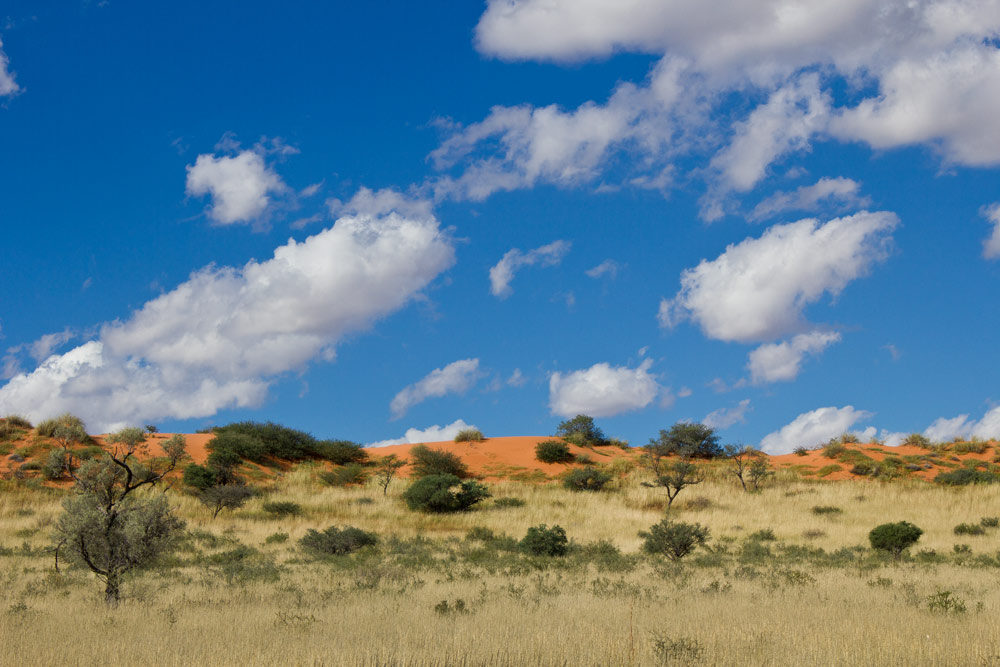
But what we love most are the animals. A surprisingly complex web of life has adapted to survive in this arid environment, including an all-star cast of large predators. We’ve spent more than six months of our lives inside the park over the last two decades and we plan to spend many more. Here is our visitor’s guide to the Kgalagadi Transfrontier Park based on our own personal experiences.
Table of Contents
What is a Transfrontier Park?
Is the kalahari a desert, kgalagadi map, how to pronounce kgalagadi, things to know before you go to the kgalagadi, kalahari mammals, kalahari birds, kalahari reptiles and amphibians , how to get there, when to visit the kgalagadi transfrontier park, do i need a 4×4 to visit the kgalagadi, where to stay on the south africa side of the kgalagadi, where to stay on the botswana side of the kgalagadi, where to stay outside of the kgalagadi transfrontier park, how to book accommodation in the kgalagadi, what to bring, kgalagadi photography tips, rules when visiting the kgalagadi, do i need a passport, how do i contact the kgalagadi national park office, can i enter the park if i don’t stay in the park overnight, can i bush camp in the wilderness or on the side of the road, can i just drive through the park to cross into another country in one day, is the kgalagadi malaria free, are the camp shops well stocked, is there an atm in the park, what currency can i use, are there gas stations in the park, is there wifi in the kgalagadi, do i need to bring my own water.
A Transfrontier Park (also known as a Peace Park) is a park that exists across an international border with no fences in between. The Kgalagadi was the first official transfrontier park in all of Africa! Two national parks, The Kalahari Gemsbok Park of South Africa and the Gemsbok National Park of Botswana, were merged in 1999 to become a single park, officially opening in 2000. The way it works is that there is a formal agreement made by both countries to manage all areas as one unit according to a streamlined management plan.
* This article may contain affiliate links. We receive a small commission at no extra cost to you. *
The Kgalagadi Transfrontier park (or KTP) lies in the Southwest corner of the Kalahari , a vast expanse of sand covering most of Botswana and parts of Namibia and South Africa. (See the Kgalagadi Map below.) It is sometimes referred to as the Kalahari Desert , but it is more accurately termed a semi-desert. An area that receives less than 255 mm of rain per year is called a desert, but the average across the entire Kalahari is slightly higher than this. In the extreme southwest of the Kalahari where the KTP lies, however, the rainfall is lowest, averaging 200 mm per year, placing it firmly within the definition of a desert. So while the entire Kalahari is not a desert, the Kgalagadi Transfrontier Park does experience desert levels of rainfall. A more accurate name is the Arid Kalahari or simply the Kalahari.
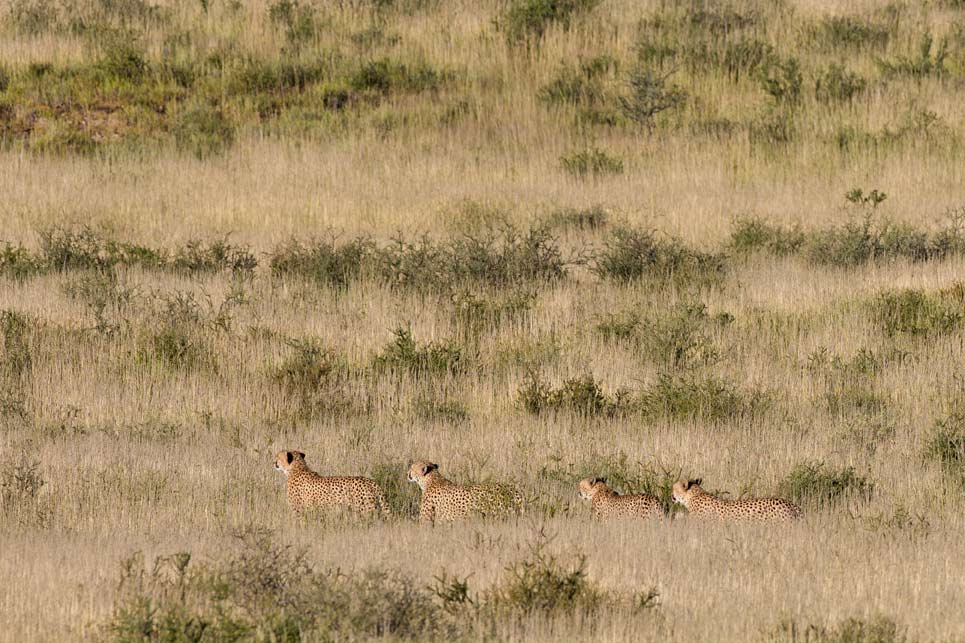
A Guide to the Kgalagadi
The park spans more than 37,000 square kilometers in both South Africa and Botswana making it one of the largest conservation areas in the world. The Botswana side is less developed and contains 75% of the park. The South Africa side has much more tourist infrastructure, as well as the majority of the iconic red sand dunes. These dunes have been stationary for thousands of years due to the stabilizing effect of grasses, shrubs, and trees.
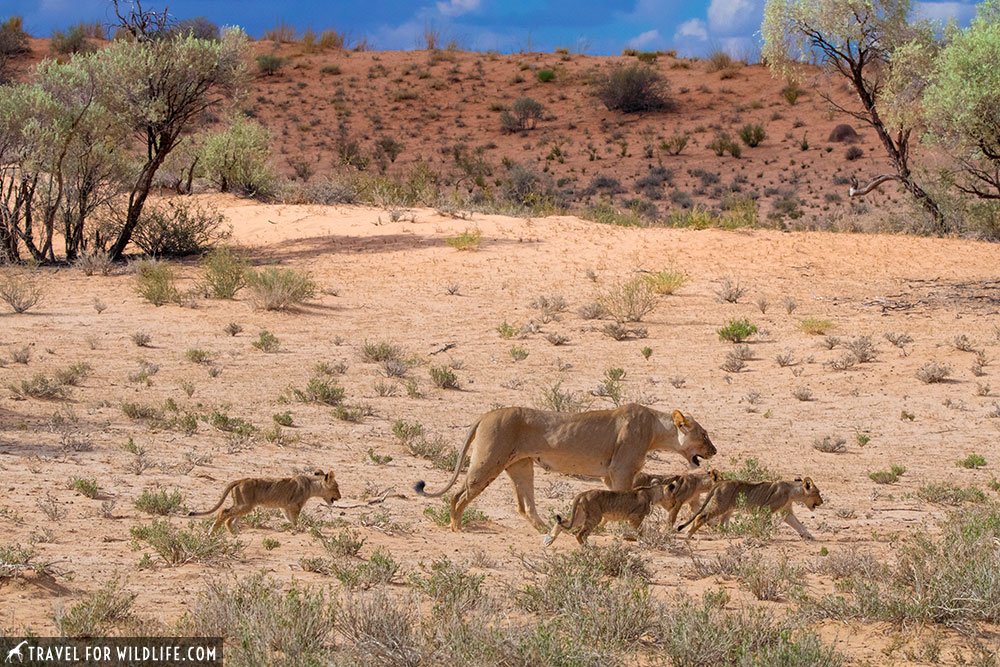
The two main roads in the park follow fossil river beds that cut through the dunes. These rivers no longer flow and only carry water in periods of exceptionally high rainfall, perhaps a couple times each century. In fact, there hasn’t been a permanent source of water in the region for millennia. It was only in the last hundred years that boreholes were drilled, first as a water supply for an impending war, now supplying waterholes that have become a focal point for wildlife.
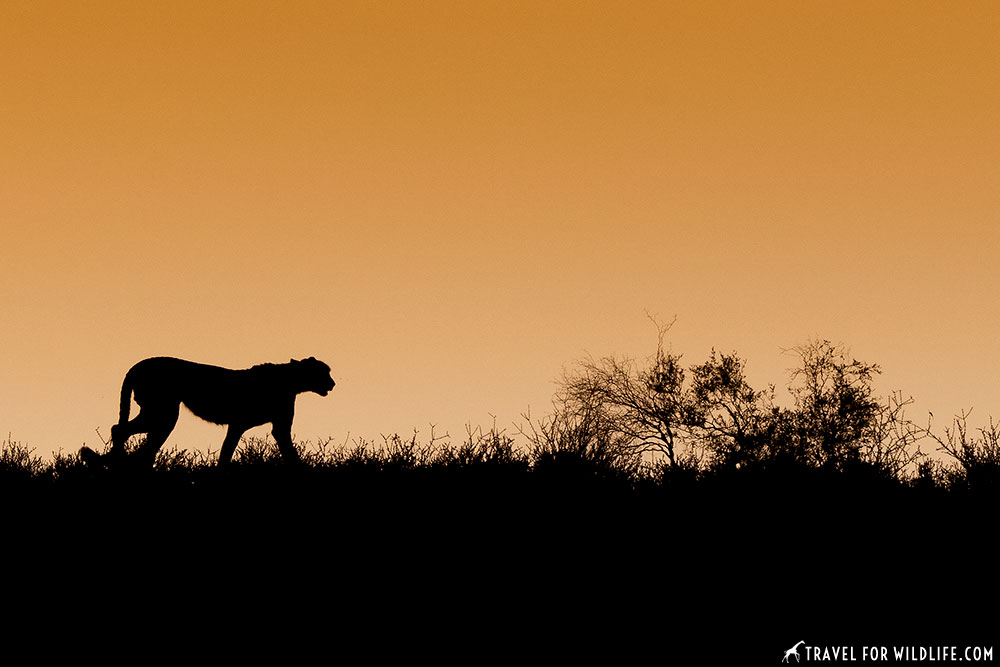
This Kgalagadi map shows the location of the Kalahari “Desert” in Southern Africa as well the location of the Kgalagadi Transfrontier Park within the Kalahari. It spans the border of South Africa and Botswana and shares its western border with Namibia.
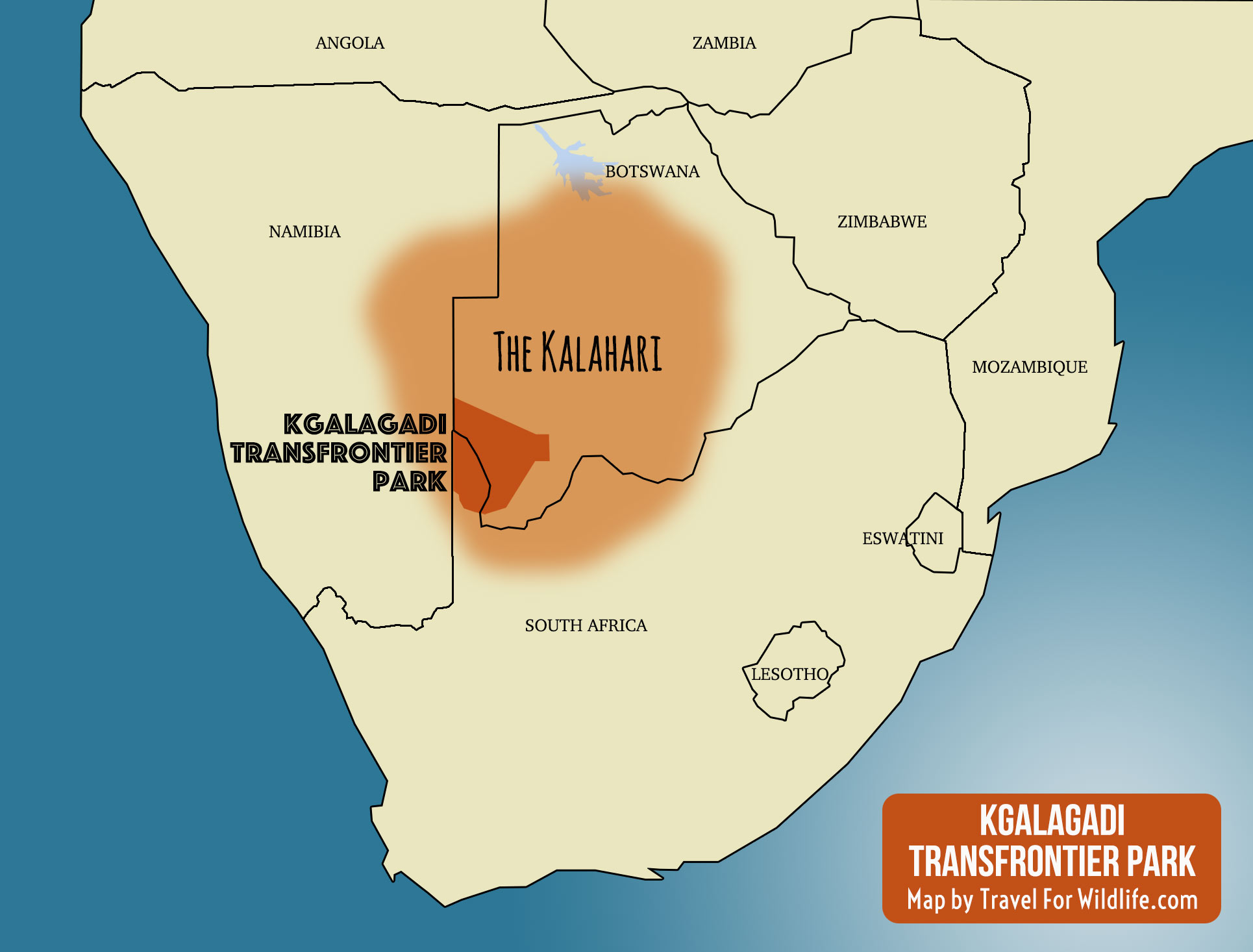
For a more detailed Kgalagadi map including all the roads, camps, and waterholes download the official park map of the Kgalagadi Transfrontier Park. Don’t worry, they’ll give you a map at reception when you check in.
One of the first questions you may ask is how to pronounce Kgalagadi? The easiest way is to simply pronounce it the same way you say Kalahari. The word Kgalagadi is said to be derived from the Kgalagadi people’s word for salt pans: Makgadikgadi. In the Afrikaans language (one of the prominent languages in South Africa), the letter g is pronounced sort of like a rough-throated h-sound or gh-sound (you know, pretend you are coughing up some phlegm) so you will often hear it pronounced ha-la-ha-dee (or gha-la-gha-dee). I know, it’s a little tough if you’re not a native Afrikaans or Dutch speaker. That’s why we just tend to say Kalahari!
This isn’t your average national park. There are challenges here, from difficult driving conditions to extreme weather. The remote location and huge open spaces mean if something goes wrong you could be stuck for hours, or even overnight, without help.
For this reason, the South Africa side of the park uses a permit system to make sure you make it safely into a camp each night. Basically you turn in your permit each evening when you enter a camp and you pick it up again when you go for your morning drive, informing the staff member which direction you intend to go. If a visitor doesn’t turn up at their designated camp, a staff member has to go searching for them.
On the Botswana side things are even more remote, especially in the Mabuasehube and in the Kaa regions! Nobody is keeping track of where you are. You must be completely self-sufficient, carry all your own water, and be prepared in case of emergency. There are no fences, no chalets, no electricity, no water (with a few exceptions), no shops, no gas stations, no ATMS. Nothing but sand and a few basics at each primitive camp site. Read our article about Visiting Mabuasehube and our Complete Guide to the Mabuasehube Campsites for more info.
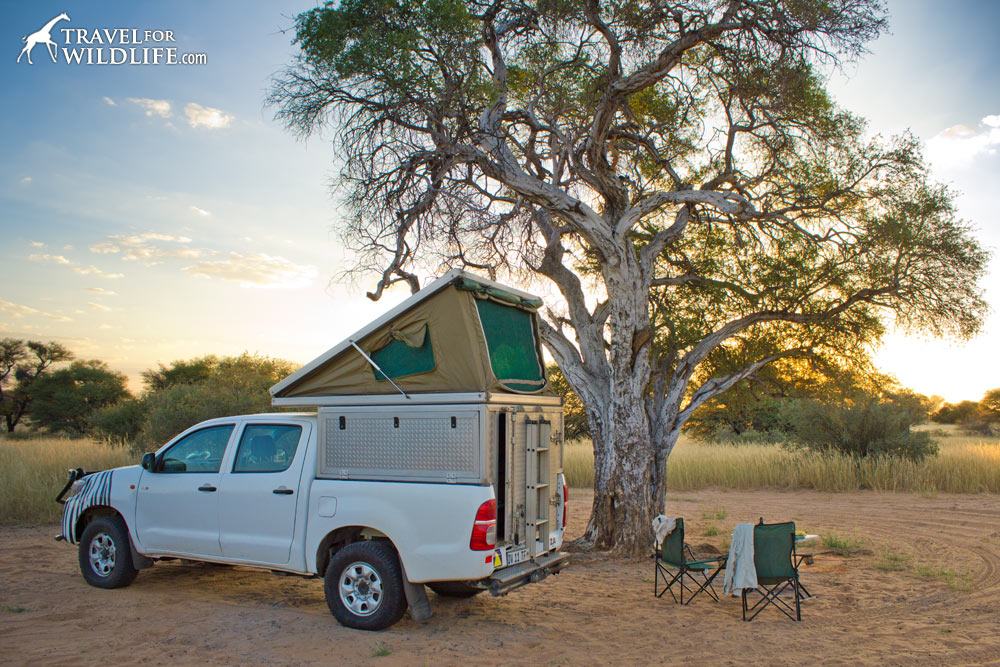
Also keep in mind there is no phone reception in the entire park. You may be able to pick up some signal from South Africa’s Vodaphone network in Twee Rivieren. Staff in Mata Mata told me they can sometimes get access to Namibia’s MTC network (though it didn’t work for us.) However, there is wifi now available in the three main camps and you can buy a voucher for it at the shops (see FAQ’s at the bottom of this article.)
Wildlife of the Kgalagadi
A wide variety of predators combined with great visibility and beautiful landscapes makes the Kgalagadi a haven for wildlife watchers and photographers. We consider the Kalahari the best place in the world to view and photograph big cats in a beautiful, unspoiled wilderness setting with very few people around.
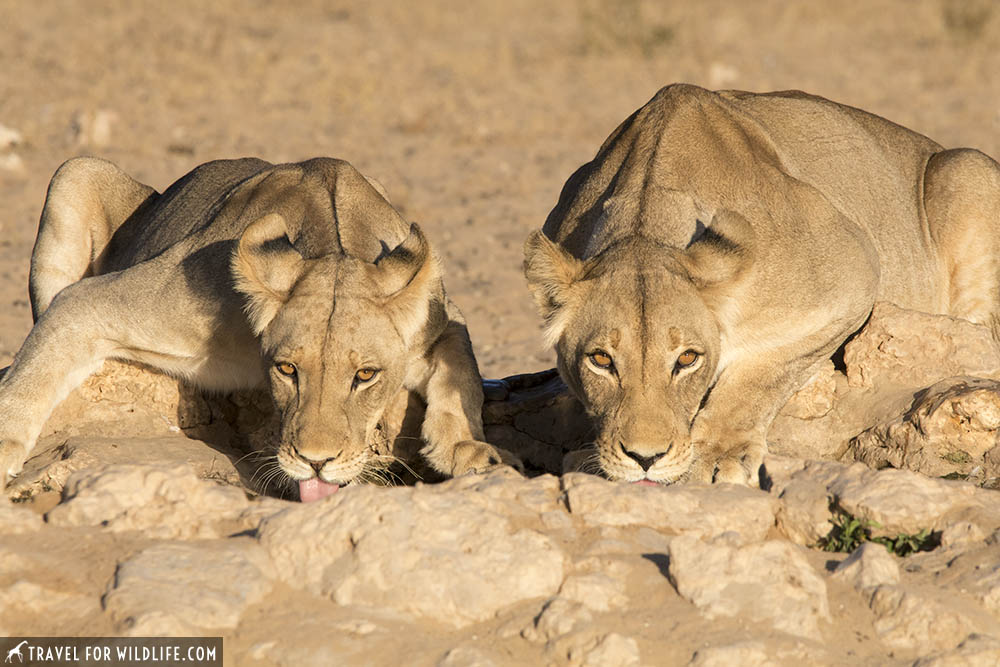
At first glance the Arid Kalahari may look like a desolate place that couldn’t support life, but in reality it is filled with a surprisingly complex web of creatures. You won’t find the same diversity as, say, in Kruger National Park (probably the highest wildlife diversity in all of Africa), but this shouldn’t be surprising considering there hasn’t been a permanent water source here for millennia! And yet, thousands of species from lizards to lions have adapted to survive in this harsh climate.

While 60 mammal species may not seem especially high for such a vast region, keep in mind that nearly a third of them are predators! This makes for some very exciting mammal watching. Like this video below of leopard cubs!
Kalahari Hoofed Mammals: While the lack of water prevents the Kgalagadi from having the biggest African mammals like Elephant, hippo, and rhino, you will still find an impressive array of ungulates, including the tallest of all (the giraffe ) and the largest antelope (the eland ). The most commonly seen antelope include springbok , wildebeest , red hartebeest , and the supremely desert-adapted gemsbok , also known as the oryx, which is the iconic symbol of the Kalahari (see our Gemsbok facts ). You may even spot the occasional kudu . Cross one of the dune roads and keep your eyes peeled for the secretive steenbok . Toward the eastern end in Botswana you can even enjoy the antics of warthogs .
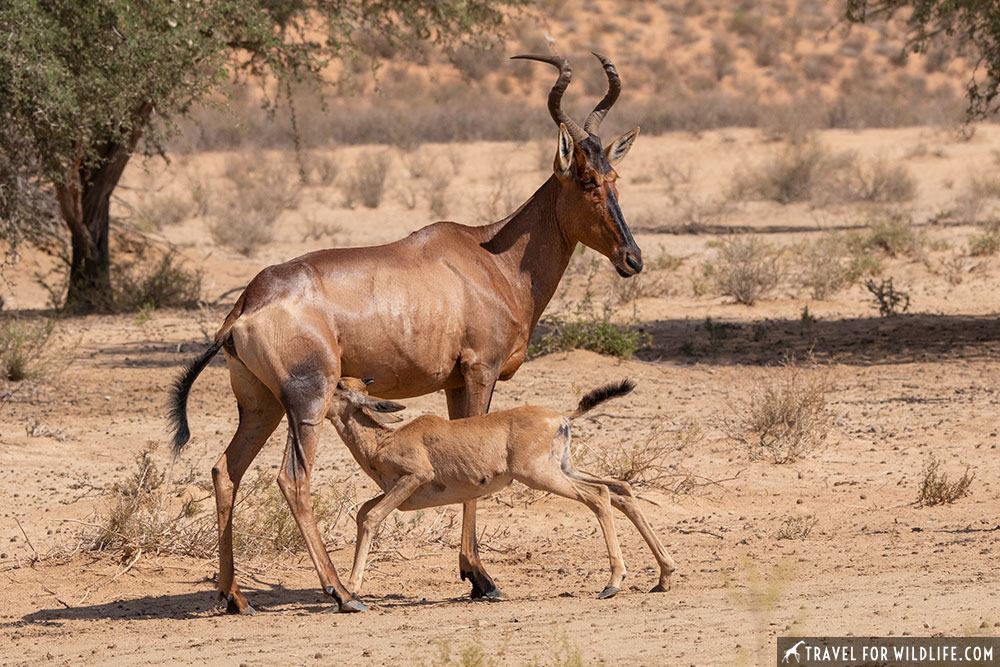
Kalahari Cats: Something you will find in abundance is carnivores. The Kalahari is a cat-watchers paradise with 5 cat species commonly seen in the park. We consider the Auob riverbed to be the best place in the world to watch cheetahs hunting.
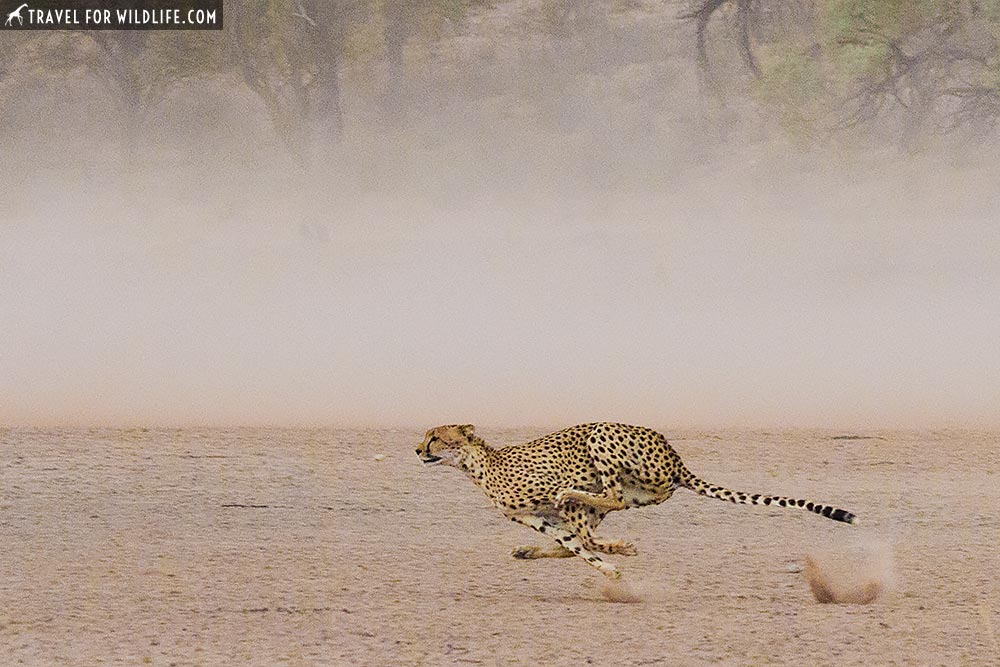
And if you want to see lions , you’ve come to the right place.During our one-month visit in 2020 we had 45 separate lion sightings representing at least 60 different individuals, including 19 small cubs! (Also check out our post What Do Lions Eat .) In most large national parks you’ll have to fight through a large traffic jam around any lion sighting, but not here. For the best chance of spotting a caracal watch the waterhole all night at wilderness camps such as Urikaruus and Grootkolk.
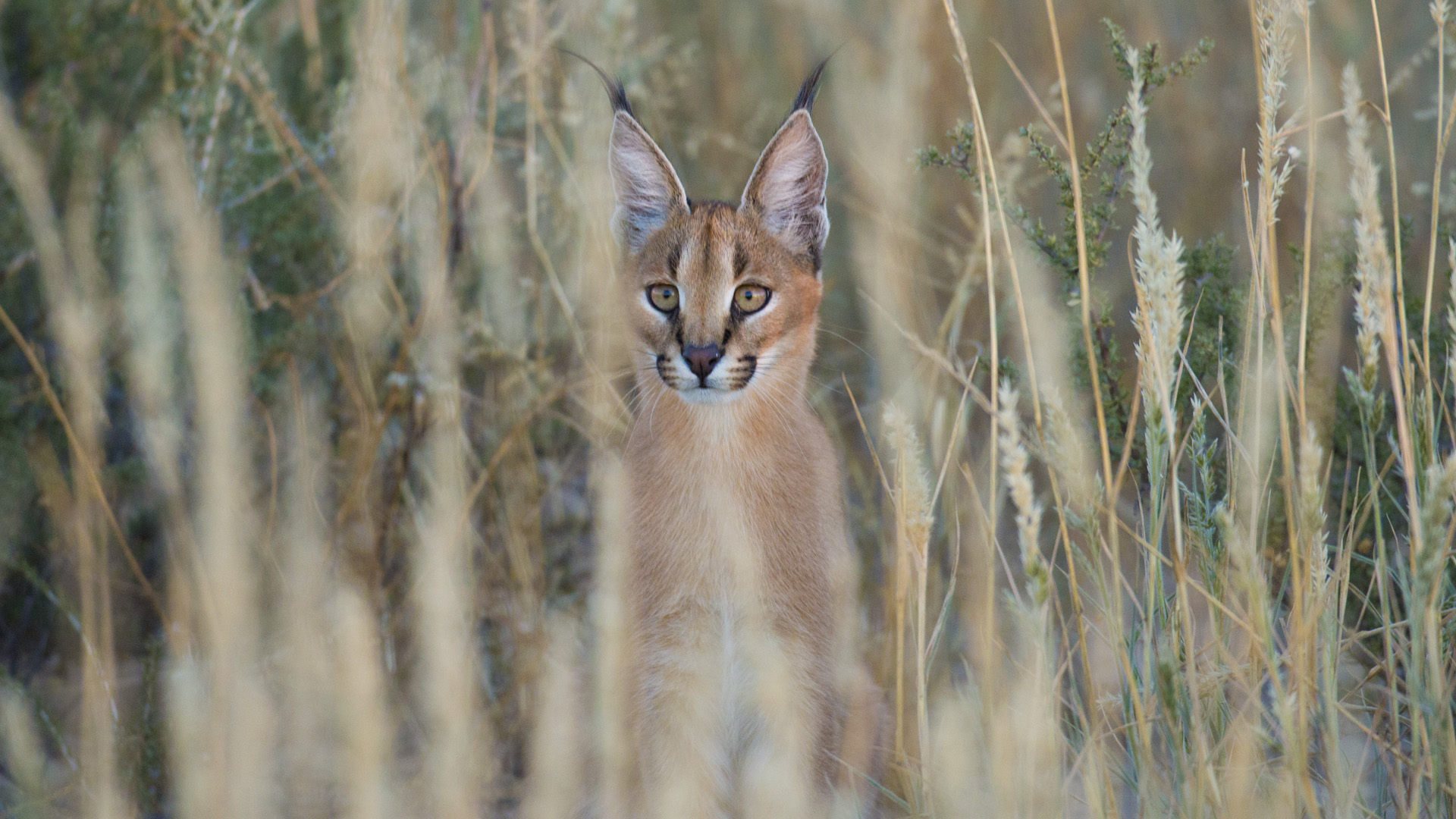
A guided night drive out of Mata Mata or Twee Rivieren offers high odds of seeing an African wild cat on the prowl, the ancestor of the domestic cat. The most coveted sighting is the elusive leopard , in my opinion the most beautiful of the big cats. Some individuals are occasionally seen in the riverbeds such as this female known as Miera with her two newborn cubs in 2020!
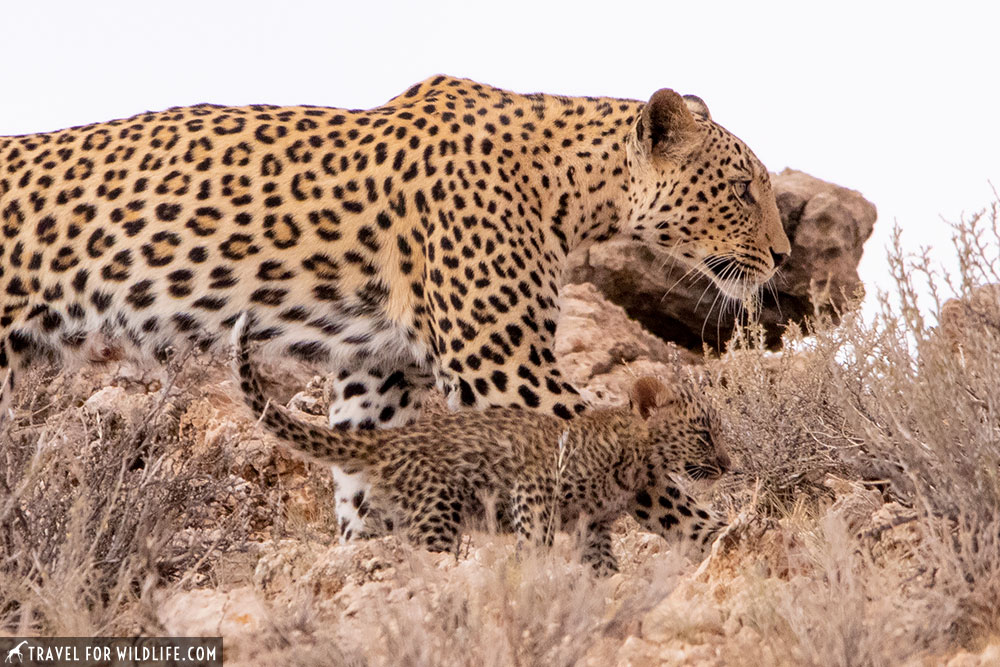
Other Kalahari Predators: Many other predators large and small are commonly sighted. Three hyena species are present including the spotted hyena and the brown hyena best viewed in early morning. Rarely a visitor may glimpse an aardwolf entering a den on the dune roads, a highly specialized hyena that eats termites. Canids include the ubiquitous black-backed jackal , and the less frequently sighted cape fox . On chilly days you may spot the comical bat-eared fox foraging at sunset. Smaller carnivores include the honey badger , small-spotted genet , yellow mongoose and slender mongoose , as well as the much-loved meerkat .
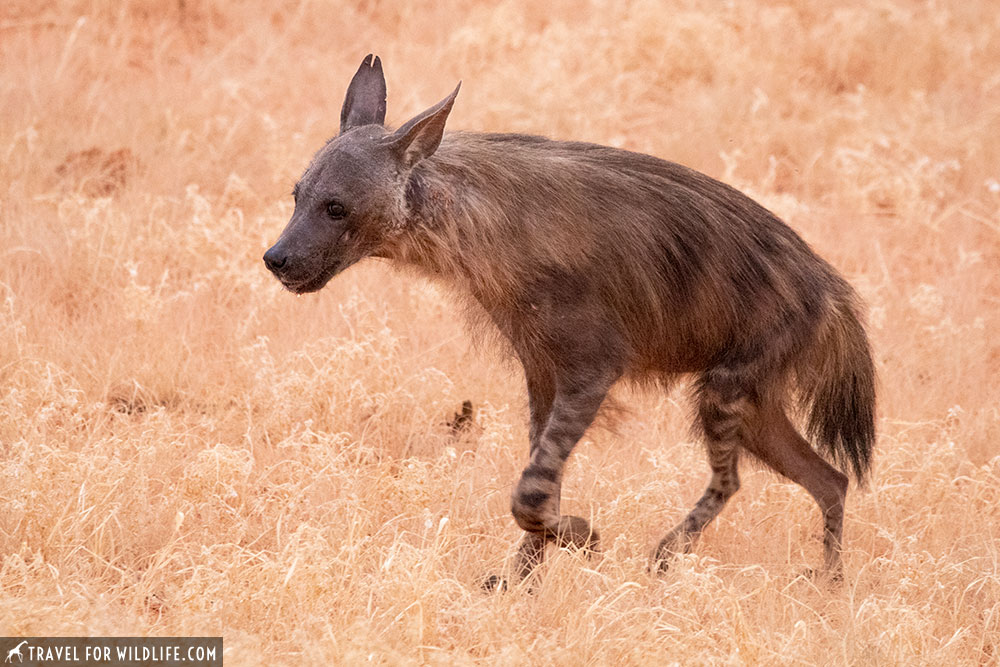
Rare Mammal Treats: The cape ground squirrel is the only rodent you’re likely to spot on a daily basis, but the nocturnal porcupine and springhare are fascinating rodents you can glimpse on a night drive. If you’re even luckier you may catch a glimpse of the bushveld elephant shrew , which is one of the Little Five animals of Africa , ( see video below) or the very shy aardvark or pangolin .
The Kgalagadi Transfontier Park is a bird-watchers paradise. Of the more than 300 species recorded in the park, roughly half of them are year round residents or regular visitors. You can readily watch the largest bird in the world, the ostrich , the mischievous hornbills , or the world’s heaviest flying bird, the kori bustard . There are so many birds to choose from that we can’t dive too deep here (stay tuned for our Kalahari Birds post coming soon.) But what we love most about Kgalagadi birding is how easy it is to watch an incredible variety of raptor species.
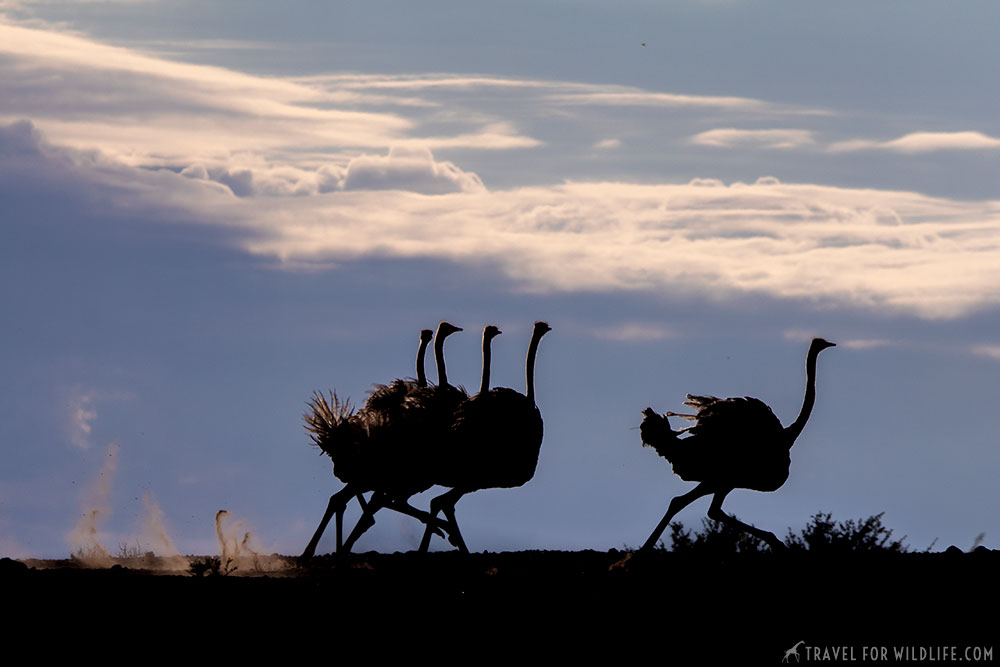
Kalahari Birds of Prey: Tawny Eagles and Bateleurs are a common sight around the waterholes. Huge secretary birds stride through the grasslands in search of reptiles. Lanner falcons scream through the air like jet planes in pursuit of doves. Massive lappet-faced vultures pace around carcasses while white-backed vultures wait for them to tear in.
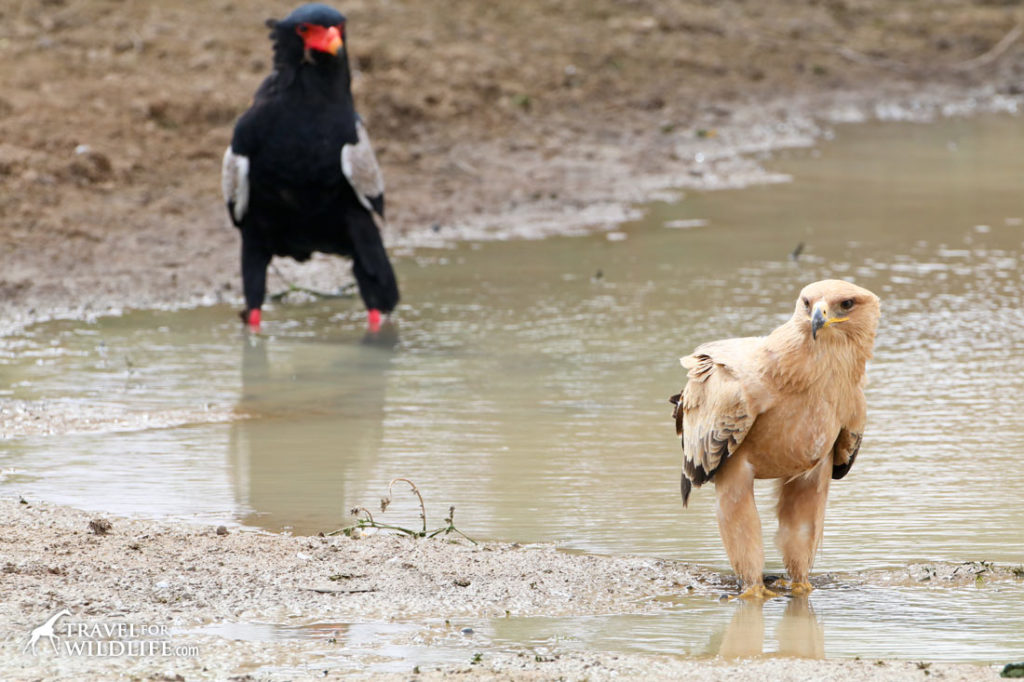
Pale-chanting goshawks call conspicuously from tree tops while the gabar goshawks hide quietly inside. The park is also a hot spot for African owls. A giant eagle owl with its pink eyelids screeches from the top of your chalet in Twee Rivieren, while resident barn owls may be found in every wilderness camp. (Check out our post South African Owls for more info.) The largest eagle in Africa, the martial eagle , swoops down to catch a springbok lamb. And this is just a small taste of the more than 36 raptor species regularly sighted in the Kgalagadi.
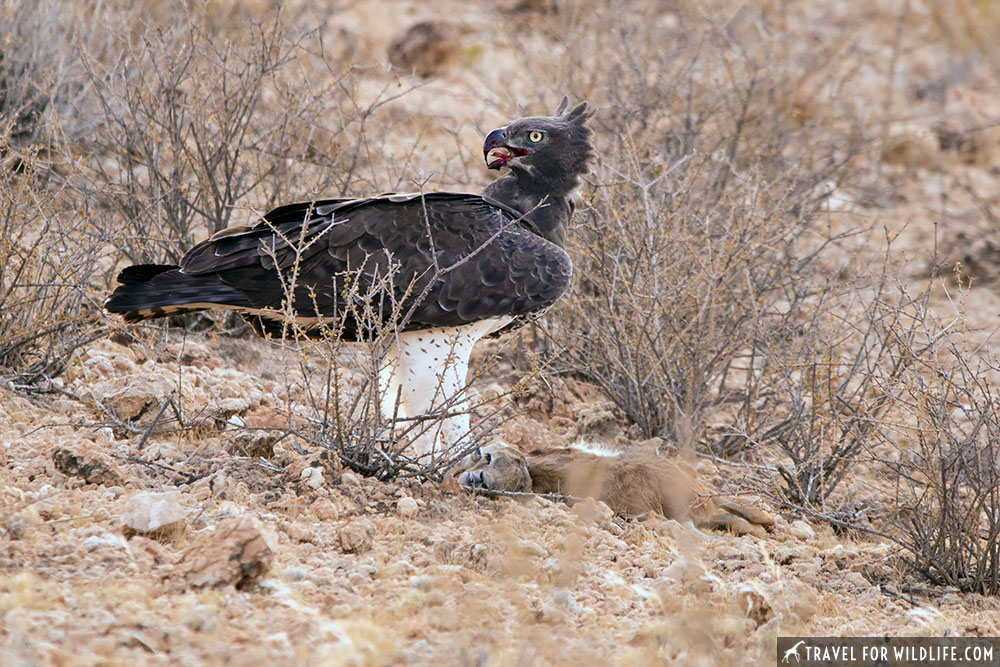
It may be surprising to learn that such a dry region supports as many as 9 frog species, including the giant bullfrog , up to eight inches long from nose to tail! They emerge from aestivation after large rainstorms and must quickly breed and return into the mud underground before puddles dry up.
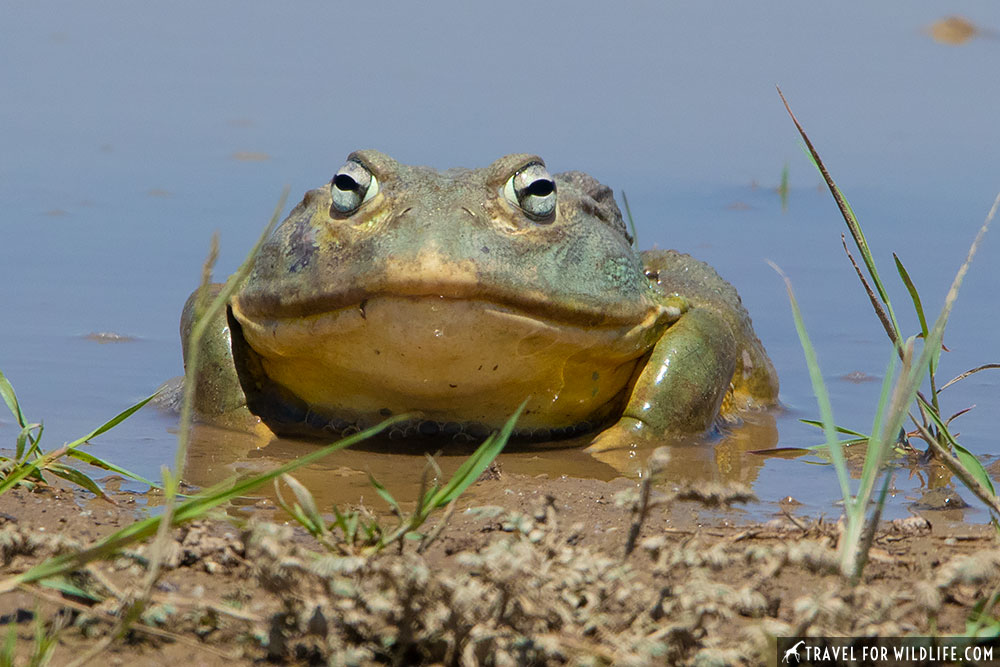
Several conspicuous snakes include the beautiful yellow-orange cape cobra (watch a cape cobra video here) and the stocky puff adder . We even spotted a horned adder by the blind in Twee Rivieren! The two tortoises found here are the large leopard tortoise , commonly seen going for a stroll after a rain, and the small and rarely seen Kalahari tent tortoise . We even once sighted the only aquatic turtle in the region, the marsh terrapin, in a water hole!
Like most arid regions, the Kalahari supports a wide diversity of lizards. The most commonly seen are the blue-chinned ground agama perched conspicuously in bushes, and the fat-bellied karasberg skink . But our favorite lizard of the Kalahari is the tiny barking geckos who serenade us every evening from their sand burrows with loud choruses of DIK DIK DIK DIK.
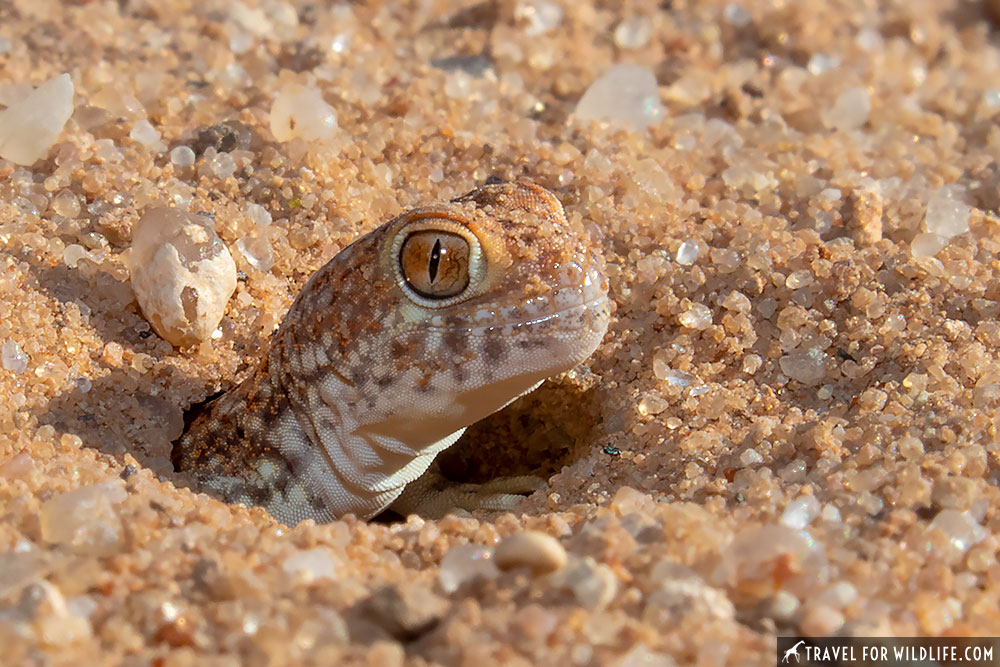
Entering from South Africa. There is no airport in the Kgalagadi Transfrontier Park so you have to drive in. The main entrance gate is at Twee Rivieren at the southern end of the park in South Africa. The closest airport to Twee Rivieren is in Upington, South Africa, about a 2.5 hour drive south of the park. However, if you are flying from another part of the world, the cheapest flights are always to Johannesburg , South Africa.
The downside of flying into Johannesburg is that it’s roughly an 11 hour drive to the Twee Rivieren entrance and a challenge to do in a single day. Also Johannesburg is a big city, annoying to drive through, and not necessarily the safest. Lately some of the towns between Johannesburg and Twee Rivieren are getting less safe for tourists as well, such as Vryburg and Kuruman. (See our article Is South Africa Safe ?) Still this is probably the most common way that visitors get to the Kgalagadi.
Another option is to enter through Namibia at the Mata Mata gate . We chose this route in 2020 to avoid some of the headaches in South Africa. We flew into the capitol city of Windhoek , rented a 4×4 camper from Asco Car Hire , and it was then about a 6.5 hour drive to the Mata Mata entrance gate. We chose to stay overnight along the way at one of our favorite stopovers, the Kalahari Anib Lodge , making for easy, pleasant driving the whole way. (stay tuned for an article about visiting the Kgalagadi from Windhoek). Keep in mind that you must cross the international border from Namibia into the park no later that 4:30 PM!
Entering from Botswana. There are actually 3 points you can enter the Kgalagadi from Botswana and each one is rather small and obscure. One is through the Mabuasehube gate which requires driving through remote and challenging sand tracks with a 4×4 (see our article about Traveling to Mabuasehube ). The other is through the north end of the park at the Kaa gate which may be even more challenging and remote than the Mabuasehube gate! Thirdly is the little-known fact that you can enter Two Rivers (the Botswana half of the Twee Rivieren rest camp) from a tiny road in Botswana that parallels the main entrance road on the South African side.
In my opinion, any month is a great time to visit the Kgalagadi, but each season has its pros and cons. Being a desert environment, temperatures can be extreme, even within the same day. Summer highs may regularly top 40° C (104°F) and winter lows can reach -10°C (14°F). The seasons work kind of like this:
- October to December: Hot and dry
- December to April: Rainy Season (and still hot)
- May to September: Cold and dry
Visiting in Summer. Our last two trips we visited in January and February . The pros are that fewer people visit this time of year so you have wider options in lodging and you’re more likely to be able to make last-minute bookings. You can sometimes feel like you’re all alone in the park! It is also baby season . We see lots of baby predators (lion cubs galore on our last trip, plus baby leopards!) as well as lots of baby antelope.
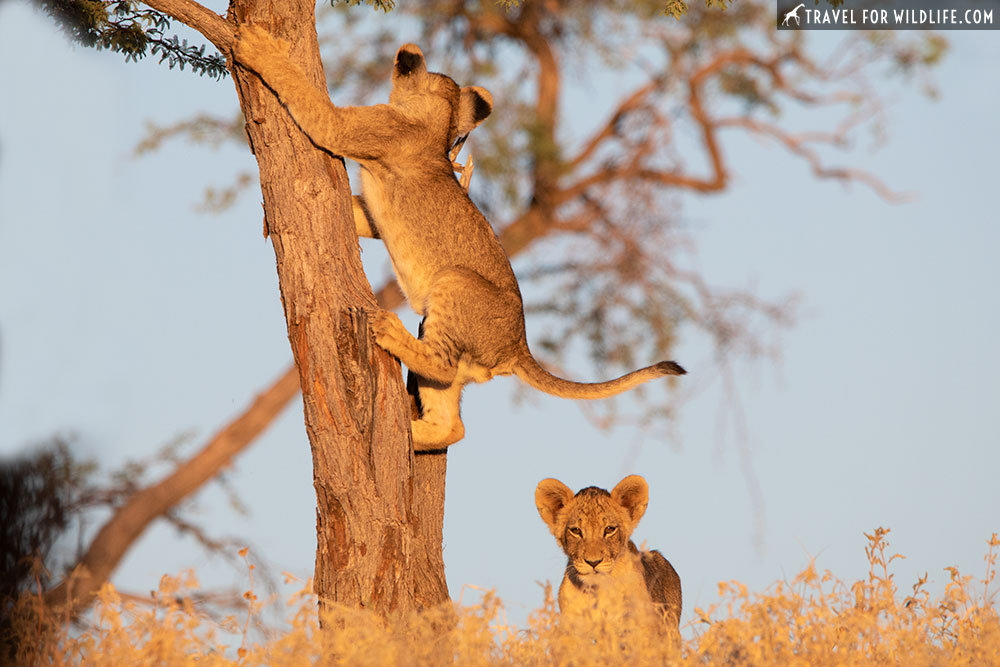
Also, when the rains begin, the flowers bloom ! The cons are that it is HOT! Regularly topping 40°C , it is sometimes just too damn hot. Animals don’t tend to be terribly active in extreme heat, but we still get tons of great sightings. Another issue is that the days are much longer in summer. If you want to be out at gate open and at gate close for the golden hours of photography, then you’ve got a long day ahead of you . This makes me pretty exhausted after a while. Sometimes the rains begin in December, sometimes they may wait until February, it just depends on the year. But keep in mind it’s possible to get a lot of rain and roads could occasionally be flooded. If the rains haven’t stared yet, it’s also possible to be really dry and game may have moved out of the region entirely in search of greener pastures!
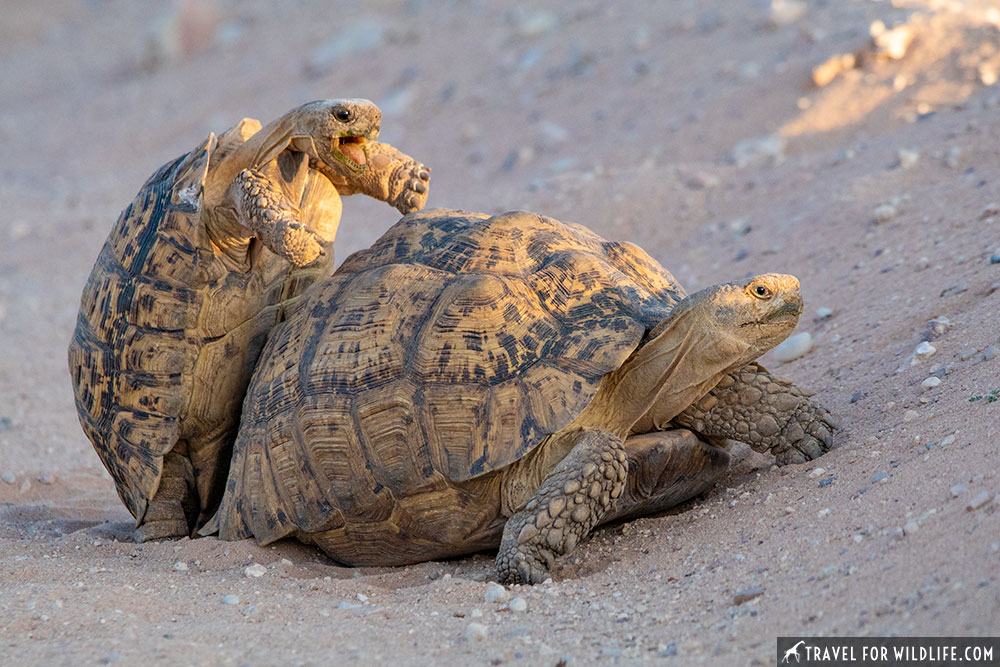
Visiting in Winter. The other extreme is July and August . The pros are that the days are shorter and it’s easier to be out at sunrise and sunset every day for the golden hour light without getting exhausted in the process. Also you have a better chance of seeing nocturnal creatures in daylight on colder days (such as bat-eared foxes and aardwolves). The cold temperatures are a bonus to me because I don’t handle extreme heat well. I’d rather camp in the cold. Cristina is the opposite, she’d rather deal with the heat. That one’s up to you. The cons are that the wilderness camp cabins have no heat and can be pretty chilly in winter. (Though they do have warm blankets and hot water showers if the pipes haven’t frozen.) Also this is when most Europeans have their vacation so it can be crowded.
In Between . March through June (Autumn? aka the green season) and September through December (Spring?) have the most moderate temperatures so it is the most popular time with visitors. March and April are at the end of the rainy season and in wet years the Kalahari will be beautifully green , but the grasses can get tall enough to make viewing difficult . This may make September through November the all-around most favorable conditions for visiting the park, but it all depends on what you like and what you want to see!
Can I Self-Drive in the Kgalagadi?
Yes you can self-drive in the Kgalagadi! In fact, unless you find a private tour that is visiting the park, it is the only way to visit the Kgalagadi Transfrontier Park! Every road in the southern half of the South African side is well-maintained and easy to drive with any vehicle (see “Do I Need a 4×4?” below.)
If you’re not comfortable with driving yourself around in the park, it is possible to drive into Twee Rivieren from South Africa or into Mata Mata from Namibia and simply pay for guided safari drives from the camp. Actually, guided night drives are the only way you’re allowed to drive around at night and we highly recommend them!
No, You don’t need a 4×4 to visit the Kgalagadi. The first several times we visited the park, we drove a regular 2-wheel-drive compact car. The trick is to lower your tire pressure to 1.6 bars. This will give you better traction in sand and will cause less washboarding on the roads. However , you can’t reach every area of the park in a 2-wheel drive. Here are the details…
The easiest places to drive in a low-clearance 2-wheel drive car is the southern end of the park. Enter at Twee Rivieren gate and you can easily drive up to the Melkvlei picnic area on the Nossob riverbed, and up to Urikaruus on the Auob riverbed. Also the lower dune cross road and upper dune crossing road are well graveled and no problem for an ordinary vehicle. This gets you to a large chunk of the park and covers most of the prime animal viewing areas. This also gets you access to three camps: Twee Rivieren, Urikaruus, and Kieliekrankie, some of our favorite places to stay! You can also enter from Namibia in a regular sedan vehicle, though you will drive gravel roads for several hours before reaching the park, and stay at the Mata Mata camp. After that, things get a little trickier.
They will tell you that the two main roads are accessible to all vehicles, all the way from Twee Rivieren to Mata Mata on the Auob riverbed and all the way from Twee Rivieren to Union’s End on the Nossob riverbed. But some sections can get quite challenging for a 2-wheel drive vehicle. In my opinion, the worst section is between Urikaruus and Mata Mata where regular traffic combined with some deep sand sections can make for difficult slip-n-slide driving at times. In fact we once got stuck around the 14th waterhole area in the middle of a cheetah jam. Another visitor in a 4×4 towed us out of the soft sand and we were fine, but these conditions can cause you to experience some white-knuckle driving in a regular car.
Similarly, the entire stretch north of Melkvlei up the Nossob riverbed can develop messy sandy patches and deep ruts (as well as obnoxious washboarding.) We have successfully driven a small car the entire Auob riverbed many times and up to Nossob as well, but having a high-clearance 4×4 vehicle makes the whole experience much more pleasant.
Other roads in the park are strictly for 4×4 vehicles . The Botswana side is strictly 4×4, so if you don’t have one or can’t afford to rent one, forget about that side of the park. There are are also two roads on the South African side, the Bitterpan road and the Gharagab road, which are strictly 4×4 and only visitors with a booking at those camps can use them.
Occasionally, in periods of extremely high rainfall, the roads will fill up with water. In these cases it is also useful to have a higher-clearance vehicle. We have bashed through deep puddles in a small compact car before and it is not ideal.
If you can afford to rent a car with higher clearance or 4 wheel drive, choose that one. If you can’t afford a 4×4, you can get by with even a tiny compact car, just stick to the south end of the park.
Where to stay in the Kgalagadi
Whether you’re looking for a rugged camping adventure or a wilderness lodge or just a simple chalet, there are plenty of lodging options available inside the Kgalagadi Transfrontier Park. But they tend to book up far in advance. Many of the wilderness camps open up for online booking a year ahead of time and then fill up instantly! With other camps you may be able to find tent sites or even chalets at the last minute. But don’t be afraid to plan ahead because the cancellation policy is fairly relaxed. Here is a guide to Kgalagadi accommodations:
Camping Sites: Camping is quite reasonably priced in the Kgalagadi Transfontier park, and there are an abundance of easily-accessed campsites in the three main rest camps: Twee Rivieren , Mata Mata , and Nossob, These are all on the South African side. Some sites have electricity, some don’t. There are even some new “premier” camp sites at Nossob that include your own private bathroom and cooking area. An alternative Kgalagadi camping experience on the South African side is to book the Nossob 4×4 Eco-Trail . To drive the trail you must have a minimum of two vehicles and you will be lead by a park guide in their own vehicle. Along the 4-day trip you will stay at three exclusive wilderness campsites! (Bookings to be made at Twee Rivieren.)
Self-Catering Chalets in the Main Rest Camps: There are a wide variety of chalets available in each of the three main rest camps: Twee Rivieren , Mata Mata , and Nossob . These main camps function like small villages, each with an assortment of lodging (chalets and campsites) a shop, a gas station, a park office, a swimming pool, a viewing hide at a waterhole, and are surrounded by a perimeter fence. The only restaurant is at Twee Rivieren which includes a lunch time take away, and a dinner dining room.
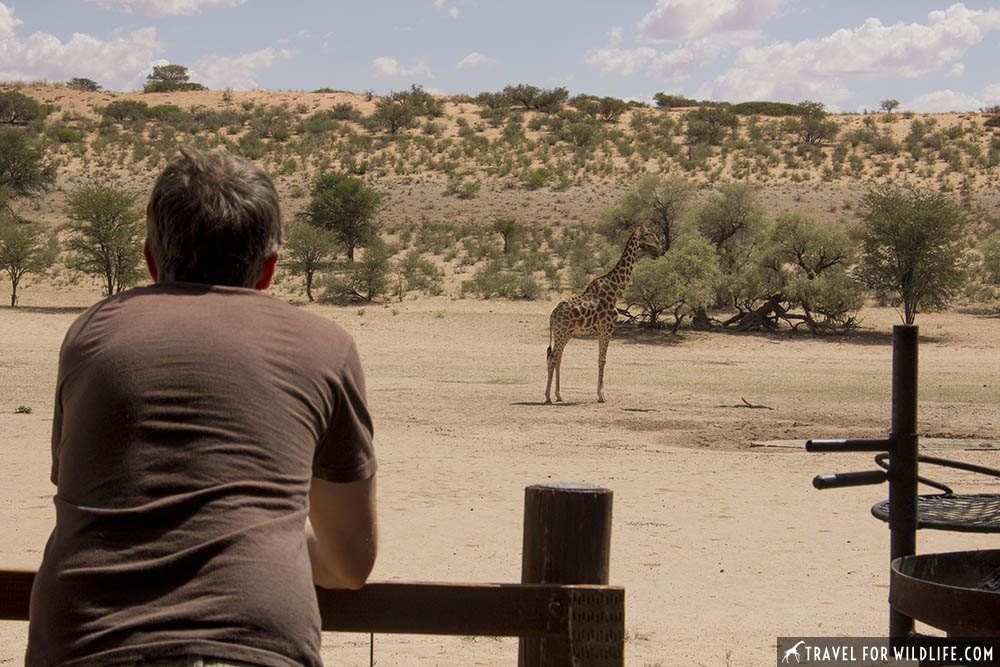
Wilderness Camps: These are the true gems of the Kgalagadi Transfrontier Park. Though they are called “camps”, there is no camping involved. In fact, each is a beautifully designed set of four cabins in a remote wilderness area of the park with no fences around it, meaning any animal may wander through at any time. For this reason, children under 12 are not allowed to stay in the wilderness camps . (But all other campsites & chalets on the South Africa side are fine for kids.) The highlight of each wilderness camp is that it overlooks a waterhole which you can watch all night to see rare nocturnal creatures like leopards, caracals, & hyenas.
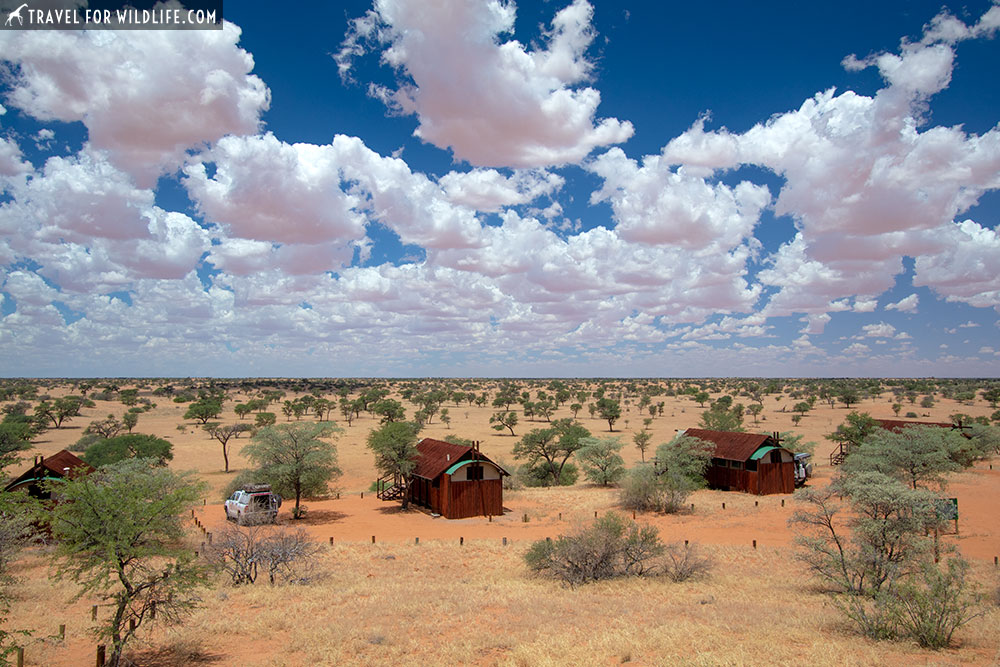
They are not fancy but they do have comfortable beds, bathrooms with hot water showers, and fully functional kitchens with refrigerator/freezer, gas stove, and all cutlery and cookware. Keep in mind that electricity is provided by solar panels so they don’t provide any power outlets, and the borehole water is too salty to drink so bring your own. To me these are the best value in African safari lodging, hands down. But because of that they book far in advance and are hard to get! Each wilderness camp has only four units, except Urikaruus which has an additional “honeymoon cabin” and the Kalahari Tented Camp which has 12 units. Here is a list of the camps. You can also click on their link for a more in depth review of each camp.
Kgalagadi Wilderness Camps
- Urikaruus (5 units)
- Kieliekrankie (4 units)
- Kalahari Tented Camp (15 units)
- Grootkolk (4 units)
- Gharagab (4 units)
- Bitterpan (4 units)
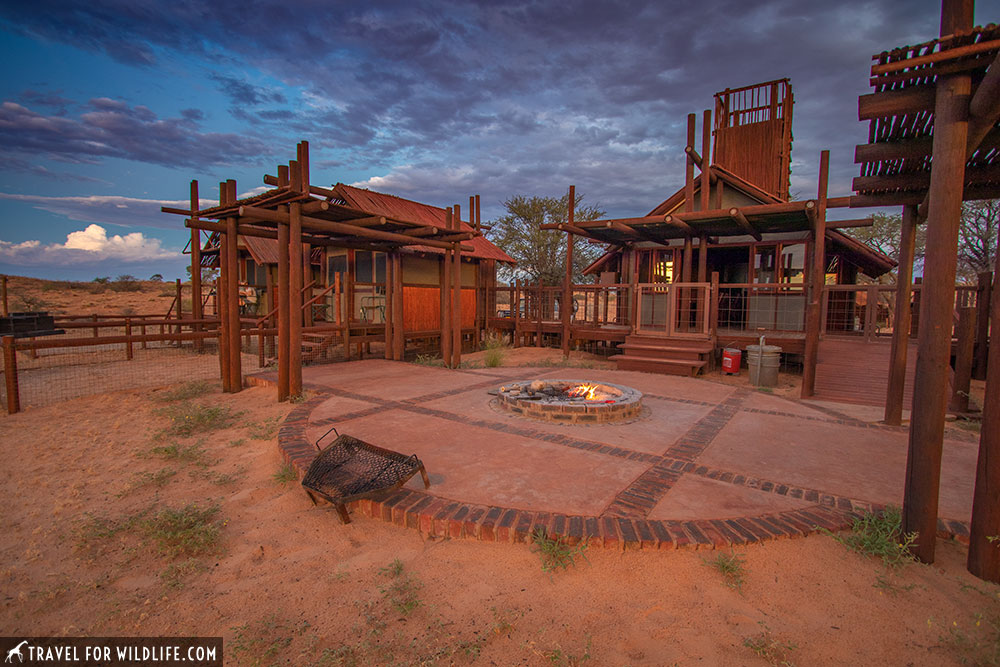
Lodges: There is only one lodge on the South African side of the park and it is called !Xaus Lodge . (Pronounced “Kaus”.) While it is essentially designed like the other wilderness camps, this luxury lodge has 12 chalets, and includes a common area where 3 meals a day are served. All activities and game drives are included. The lodge is located on the western edge of the park between the San Heritage Land and the Miera Heritage Land. While the lodge is a bit pricey, it has the great benefit of helping preserve San culture and providing an authentic cultural experience .
The lodging options on the Botswana side of the Kgalagadi Transfrontier Park are limited to primitive wilderness camping and two lodges.
Botswana Kgalagadi Camping. There are three main camping areas on the Botswana side of the Kgalagadi:
1) The “ front country ” camping areas are easily accessible from the main Nossob road (just across the Botswana border). These include the Two Rivers campground, the Rooiputs campground, and the Polentswa campground. Each of these camping areas has a limited number of sites (3 to 6) with very few facilities. They are unfenced and most have only an A-frame structure for shade and a pit toilet. While they are fairly close to the main road, the access road may have deep sand and be challenging for a 2-wheel-drive vehicle. Therefore they are marked as 4×4 only.
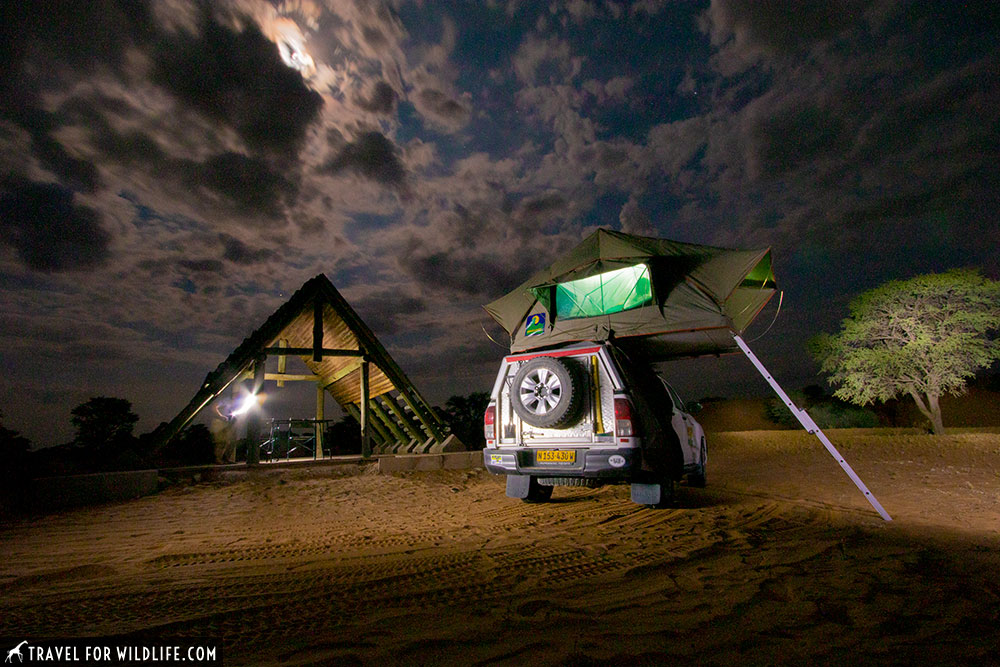
2) The Mabuasehube area . In the extreme eastern edge of the park lies the remote Mabuasehube camp sites. There are only 17 sites and they are primitive, like the ‘front country’ ones above. However, these sites are far off the beaten path and require a 4×4 to get there. Read our Complete Guide to the Mabuasehube Campsites and our companion article Traveling to Mabuasehube .
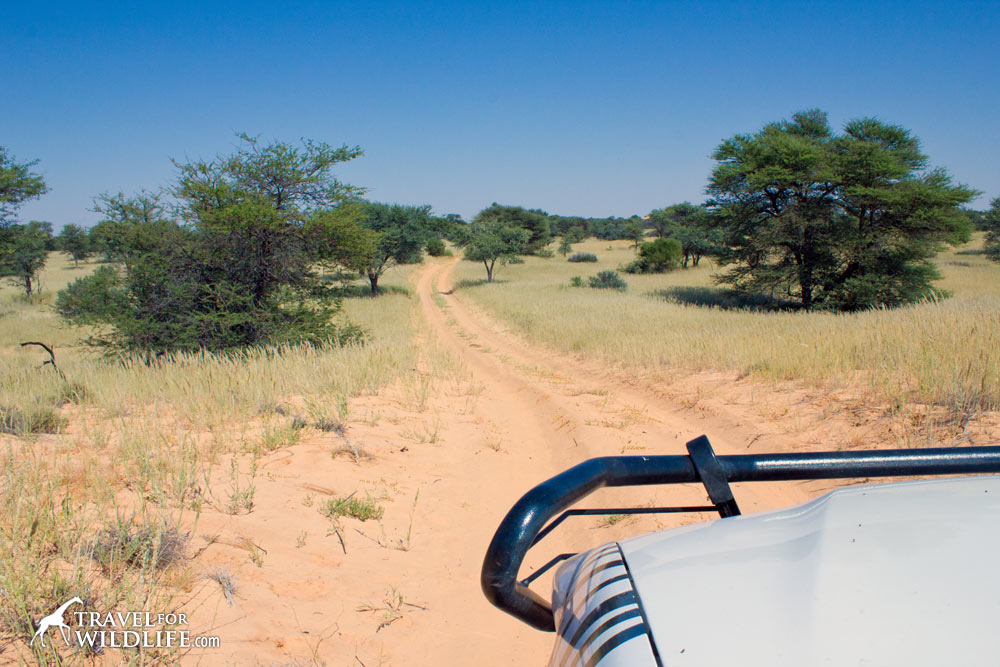
3) The Kaa region .The remote northern end of the Kgalagadi Transfrontier Park is known as the Kaa region. There are a few 4×4 trails that can be followed to a series of primitive wilderness campsites. There are generally lower wildlife concentrations here so Kaa is more about a remote wilderness adventure than wildlife viewing
Lodges in the Botswana side of the Kgalagadi.
There are two lodges located on the Botswana side of the Kgalagadi, both managed by Ta Shebube. One is the Rooiputs Lodge and the other is the Polentswa Lodge . Visit the Ta Shebube website for more information.
If you just want to pop into the park for day trips, keep in mind that the park limits the number of day visitors that can enter each day to 20 cars maximum . Call reception for more info (054-561-2000).
Another reason you may want to stay outside the park is that you might find yourself arriving too late to enter the park before gate closing time. If you’re entering from South Africa at the main Twee Rivieren gate, your best option is the Kgalagadi Lodge just 5 km from the gate. It has comfortable chalets with a nice view, campsites, and an excellent restaurant and shop. Another nice option is Kalahari Trails about 35 km south of the entrance. They offer excellent walking tours and rescue meerkats!
If you’re coming in from Namibia through Mata Mata, keep in mind the border crossing closes at 4:30 PM so if you arrive after that you’ll need to find accommodation outside the park in Namibia. There is a small Farmstall just 200 meters from the border that has a few chalets and campsites, and another called Kalahari Farmstall & Accommodation about 15 km back with reasonably priced chalets, camping and a nice coffee shop on site.
If you’re entering from Botswana at either the Mabuasehube gate or the Kaa gate you won’t find any nearby lodging options so plan ahead!
If you want to book accommodation in the South African side of the Kgalagadi , or check SANParks availability , the easiest way is through the SANparks website It is well organized and efficient. You can pay with credit card through the website. But wilderness lodges do tend to book up far in advance so plan ahead! Here is some more contact information for Kgalagadi reservations on the South Africa side.
Contact South Africa Kgalagadi Transfrontier Park Reservations
- SANParks Central Reservations Tel: 012-428-9111
- E-mail: [email protected]
- Web: sanparks.org
- Kgalagadi Transfrontier Park phone: 054-561-2000
To make reservations at the lodges on the Botswana side ( Rooiputs lodge and Polentswa lodge ) you can book them through the Tashebube website.
If you want to camp on the Botswana side …well that is more complicated. In fact, it is so complicated that we’ve dedicated a whole article to it. Check out our post Camping in Botswana: How to Make a Reservation . If you’re staying in Mabua then check which campsite you’d like to stay in with our guide to Mabuasehube campsites . (Also stay tuned for a post about camping at Polentswa, Rooiputs, and Two Rivers on the Botswana side, coming soon.)
Contact Botswana Reservations for Kgalagadi Transfrontier Park
- DWNP reservations Tel: +267-318-0774
- Email: [email protected]
Having visited many times we’ve developed a list of items that we can’t live without in the Kgalagadi. Here are some of those items For tips on the photography items we bring, see Kgalagadi Photography Tips in the next section. Also check out our article How to Choose Your Safari Shoes .
- headlamp (Petzl Aktik Core)
- high powered flashlight for waterhole viewing at wilderness camps (Olight) Please use a red filter to not bother wildlife.
- solar powered lantern (both for camping & in the wilderness camp cabins)
- cigarette lighter inverter for charging batteries while driving
- compact binoculars
- silicon popsicle molds (an awesome treat in the remote wilderness camps!)
- South Africa power adapter (from your country!)
Here is a list of our favorite guide books we always bring to the Kgalagadi. For more, see our article Books to Take on an African Safari .
- A Natural History Guide to the Arid Kalahari
- Animals of the Kgalagadi
- Birds of Southern Africa (Robert’s Bird Guide is another good one)
- The Behavior Guide to African Mammals
- On Track (ID Guide to Southern African Animal Tracks)
The Kgalagadi Transfrontier Park is amazing for wildlife photography. Low and open vegetation makes for unparalleled viewing and visibility. An incredibly array of predators, both mammalian and avian, makes for lots of exciting wildlife photo opportunities.Here are a few of our Kgalagadi photography tips . Also check out our post about The Jumping Jackals of Nossob & How to Photograph Them .
Lenses. Do you need to have a super telephoto 600mm lens? No. Often animals will be standing right next to the road. However, you should give animals their space so that 1) you don’t frighten them and cause them to expend energy unnecessarily and 2) to keep your distance from potentially dangerous animals like lions & leopards. For that reason, I think it makes sense to bring the longest lenses you can afford. I used to use big monsters like the Nikon 600 f4 the Canon 500 f4. Yes they take amazing photos, but they are also a pain in the butt to travel with and ridiculously expensive.
If you want to photograph birds, a long lens is indispensable . On our last trip I shot with a Sigma 150-600mm and I really enjoyed it. It’s a light-weight, versatile lens for a great price. Keep in mind that it has a smaller max aperture which makes it tougher to get sharp photos and rich color in lower light situations. However, the huge zoom range allows you to capture the best composition in any situation, not just a closeup of a face. Don’t forget a wide angle for all those beautiful landscapes!
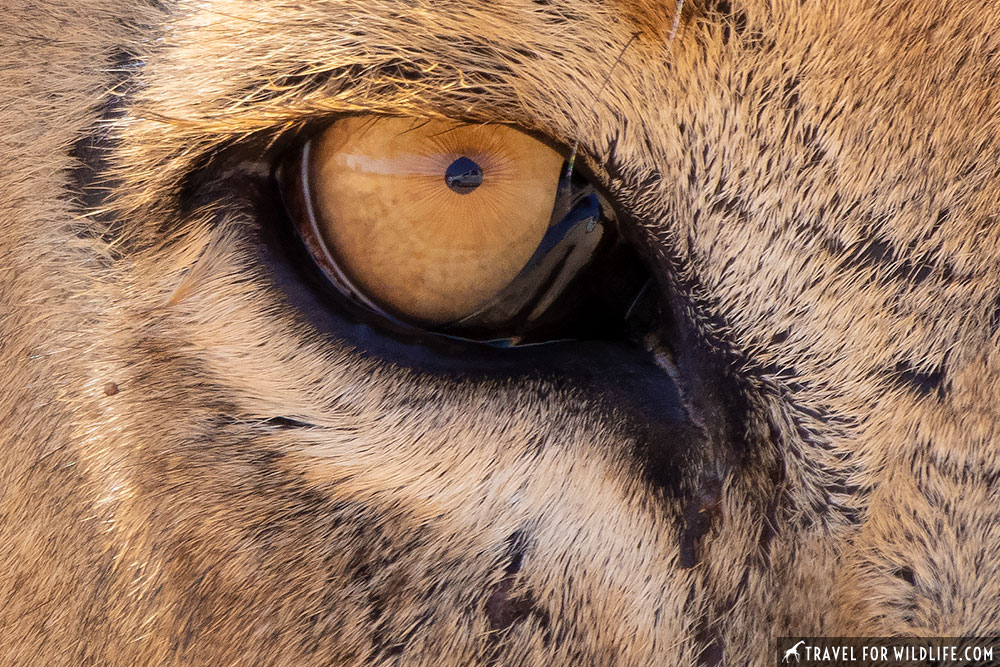
Bring a bean bag. Keep in mind that you are not allowed to get out of your car in the park, except in a couple designated picnic areas. This means most of your photos are taken out of a car window. Many locals in Southern Africa who are regulars in the park have added custom mounts to the outside of their car door for mounting heavy lenses. Since this isn’t really an option for visitors renting a car, I still find that a good old-fashioned bean bag is the best option . On my first visit to Africa decades ago I made a bean bag out of the leg of an old pair of jeans and used the fly to close it up. I still use the same one today. I bring it empty and then fill it with bags of rice , (still in the plastic package) when I arrive. Then I have an emergency food source too! There are plenty of commercial options available as well. Forgot to bring a bean bag? Throw a large bag of rice into a drawstring sack. Boom, good to go.
Should I bring a tripod? That depends. As stated above, you’ll spend most of your time shooting from a car where a tripod isn’t really an option. On the other hand, if you’ll be staying in some of the wilderness camps (see Where to Stay below) then a tripod is very useful . Each wilderness camp has a deck or patio from which you can photograph the waterhole. While there are railings around these decks that you can plop a bean bag on top of, a tripod makes much more sense here.
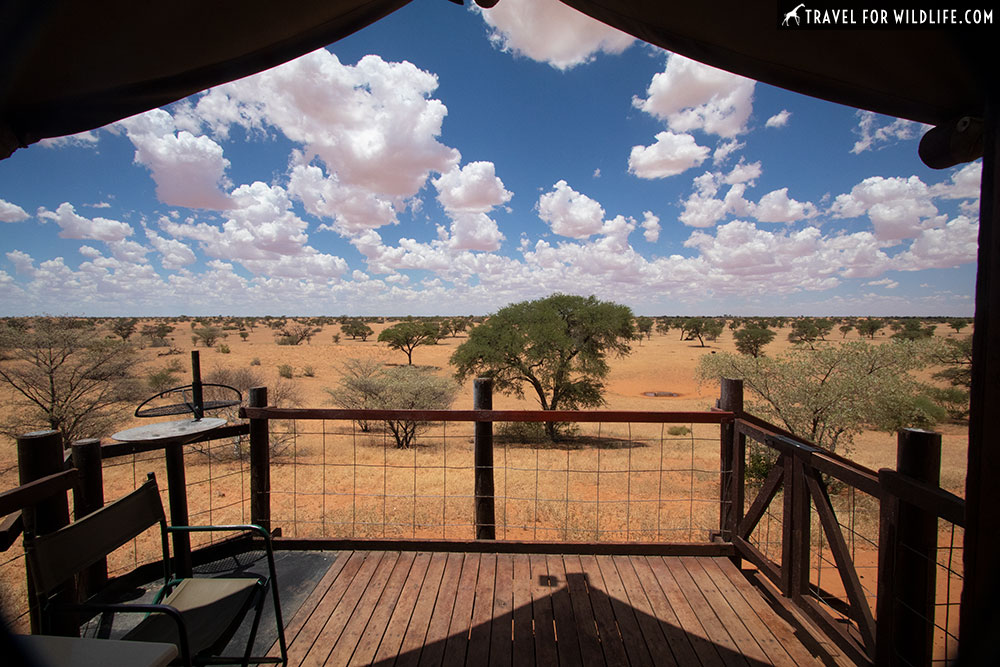
Shooting at Night. As mentioned above, the wilderness camps offer you a rare chance to photograph hard-to-see nocturnal predators at the camp waterholes. While there is always a light shining on the waterhole, these tend to be too dim for shooting. Yes you can shoot with an insanely high ISO and get a grainy picture that is exposed well if your subject is holding still. But a better bet is to bring a powerful flashlight . (See our What to Bring section above.) Remember not to overdo it with flashlights . It is unpleasant for the animals to have a bright light shining in their face and can cause temporary blindness, making them vulnerable to predators. Instead, shine the light next to them. Also it can call attention to prey animals who may be trying to avoid predators, or predators trying to hunt. Another option is to bring a strong flash, possibly with a flash extender . But even this combination may have trouble reaching the distance to most waterholes.
Adhere to the gates hours at every camp . You must be inside one of the main camps, wilderness camps, or designated camping sites every single night you are in the park. You have to be back in camp by gate closing time and you can’t leave camp until gate opening time in the morning. These times vary from month to month based on sunrise and sunset, but are consistent between every camp in the park. You can find them in the park guide, posted at every camp gate, and listed below. Keep in mind that on your day of arrival you need to enter the park with enough time to drive (under the speed limit) to your first reserved restcamp or else they will not let you enter the park! Don’t worry, there are a few lodging options outside the park.
Kgalagadi Transfrontier Park Gate Times:
- January 5:30 AM to 7:30 PM
- February 6:00 AM to 7:30 PM
- March 6:30 AM to 7:00 PM
- April 7:00 AM to 6:30 PM
- May 7:00 AM to 6:00 PM
- June 7:30 AM to 6:00 PM
- July 7:30 AM to 6:00 PM
- August 7:00 AM to 6:30 PM
- September 6:30 AM to 6:30 PM
- October 6:00 AM to 7:00 PM
- November 5:30 AM to 7:30 PM
- December 5:30 AM to 7:30 PM
Do not speed . Speed limit in the park is 50 km/hour . If you are at an awesome sighting and it’s getting late, I’m sorry but you have to leave. If you get to your restcamp later than gate closing time you’ll be fined. They also have random radar speed checks along the roads, and they will get you. So please don’t speed.
Do not feed wildlife . This includes providing bird baths to birds.
Do not play music . Respect your neighbors (people or wildlife). The official guide states “no noise whatsoever between 9pm and 7am.”
Do not get out of your car while in the park, not even half your body outside the window or door or sunroof. You’ll be fined if you do and other guests are likely to report you if they see you. You are only allowed to get out at rest camps and in designated areas (such as the picnic areas) but you do this at your own risk and you must look around and pay attention!
Do not drive off road . The Kalahari is a fragile ecosystem, and any damage might take decades to heal.
No drones. As with all national parks in South Africa (and most of the world) the use of camera drones inside and over the park is strictly prohibited. If you travel with a drone you must disclose that at Reception.
Other assorted rules:
- Do not gather firewood
- Lower your tire pressure to 1.6 bars to reduce washboarding & get better traction
- Keep your eyes open for snakes and scorpions when walking around the camps at night and carry a flashlight
What to do if you see someone breaking the rules? Take photos of the infraction, including a clear photo of the car’s license plate. Then you can take it to the ranger on duty (ask at reception). With the number plate they can trace where the guest is staying and they’ll be issued a fine. This way you avoid an unpleasant interaction.
In addition, please refer to our Safari Etiquette Guide for some tips on what to do and what not to do when watching wildlife while on a safari.
Frequently Asked Questions:
If you are entering and leaving the park through the same country you don’t need a passport. But if you are entering the park through one country and leaving the park through another country, you do. The Botswana and South Africa passport control office is in Twee Rivieren (called Two Rivers in Botswana). If entering from or exiting into Namibia, your passport control office is in Mata Mata. The border post hours are:
Twee Rivieren: 7:30 am to 4 pm Mata Mata: 8 am to 4:30 pm
So if you are entering the park through Mata Mata you need to be at the gate before the border post closes (4:30 pm). If you arrive after gate close, you can find accommodation near Mata Mata, (See Where to Stay Outside the Park above).
Please note that we they are unable to assist with reservations. Contact 012 428 9111/[email protected]/ www.sanparks.org for reservations.
Kgalagadi National Park phone numbers:
Emergency and Duty Number : 073 224 3484
Twee Rivieren Duty Manager: 054 561 2029
Twee Rivieren Reception: 054 561 2005 / 2050
Yes you can. A maximum number of 20 cars per day are allowed to recieve a day pass. You need to enter and leave through the same gate. Most of these visitors stay at the Kgalagadi Lodge, just south of the Twee Rivieren entrance.
No, wild camping is not allowed in the park, only in pre-booked, designated campsites. In fact, if you don’t have accommodation (chalets or camping) booked you won’t be let in (unless you’re one of the 20 vehicles each day who are given a daily pass).
No, you can’t. The rules state that you need to stay in the park for a minimum of two nights. This is to discourage people from speeding and creating problems for others.
Yes, the Kgalagadi is malaria-free. While there are, on rare occasions, a few mosquitoes in the park (during times of heavy rain), the Kgalagadi Transfrontier Park is outside the malaria zone.
Whenever we visit, we do our main shopping before arriving at the park, either in Upington in South Africa or in Mariental in Namibia. Then we get remaining necessities at the shops in the park. While their offerings are not amazing, we’ve always survived. The main shop at Twee Rivieren is the one with the most variety. You’ll find dry goods, wine, frozen meat, snacks, water, firewood, yogurt, cheese, and some veggies (tomato, cucumber, lettuce…) pretty basic but you’ll even find ice cream and the only cashpoint in the park! (see Is There an ATM in the Park below.
The Nossob and Mata Mata shop are much smaller with fewer products. Fresh produce is harder to find so get some if you see it! If you need something specific, get it before you enter the park. If you are buying alcohol remember that under South African law no alcohol is sold on Sundays. And ladies, bring your tampons with you, because Cristina couldn’t find any!
Yes, there is an ATM (cashpoint) in the shop at Twee Rivieren, but note that sometimes it doesn’t have any cash in it! Often you’ll be told that they’ll put some cash in at 3:00 PM at the employee shift change when they empty the drawer. We’ve also been told that if the ATM is out of cash you can go to reception and they can give you cash using your debit card, though we haven’t tried it personally.
You must use South African rands in the South African side and Pula in the Botswana side. Namibian dollars are not accepted (but they accept them for border fees when entering or exiting the Mata Mata border post to Namibia.)
Yes, there is a gas station in each one of the main rest camps (Twee Rivieren, Mata Mata, and Nossob). While prices are understandably a bit higher than outside the park, it isn’t outrageous. They do accept credit cards. Keep in mind that on some occasions it can get so hot in the afternoon that the pumps won’t function, so you’re better off refueling in the morning or evening on very hot days!
Yes, there is. But only at the three main restcamps. Signal is very weak and you’ll only be able to pick it up by the shop at each of the camps. You’ll need a voucher to get wifi, purchased in the shops for 75R.
If you have a South African mobile phone card, you can pick up signal only at Twee Rivieren. If you have a Namibian mobile phone card they say you can get signal at Mata Mata but that was not the case for us. I don’t think you can get Botswana signal anywhere in the park.
One thing to remember is that water is very scarce in the Kalahari. Please use it responsibly.
If you are staying at the main camps (Twee Rivieren, Mata Mata, and Nossob), water is available but you might want to bring your own drinking water. (You can buy drinking water at each of the camps in both large and small bottles.) If you are staying in the wilderness camps or are camping in the remote Botswana sites, you need to bring your own drinking water. The water in the wilderness camps comes from boreholes (wells) and it is very salty/mineralized. While this is the water you’ll use for showering and dishwashing, it is not advisable to drink it.
The Kgalagadi Transfrontier Park isn’t for everyone. It definitely is NOT Kruger . But we find the challenges to be worth it. We are sometimes hesitant to promote it, because if tourism continues to grow and that growth isn’t managed properly, it could destroy the very place we love so much. If you visit and become a Kalahari fanatic like we are, then let’s all work together to protect this special place for generations to come.
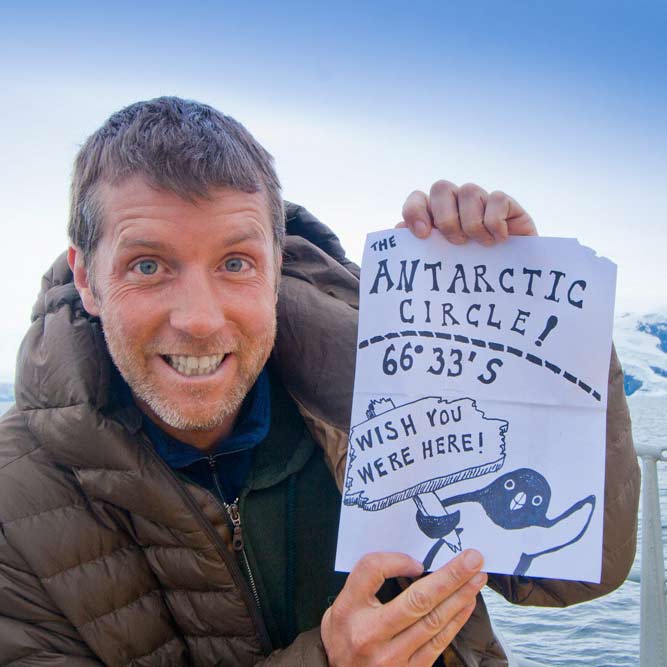
Hal Brindley
Brindley is an American conservation biologist, wildlife photographer, filmmaker, writer, and illustrator living in Asheville, NC. He studied black-footed cats in Namibia for his master’s research, has traveled to all seven continents, and loves native plant gardening. See more of his work at Travel for Wildlife , Truly Wild , Our Wild Yard , & Naturalist Studio .
Sunday 28th of May 2023
Hello again, I forgot to ask: is there anywhere where I can see (fairly tame) bush babies? I can't imagine that the vegetation in the Trans Frontier would work for them, but I'm in love with them too and I know that there is a feeding station at Nata, where it's very easy to take photos... but anything similar in the Trans Frontier ??? (and I DO realise that bribing animals with food is really, really bad practice... but I wouldn't be the one doing it ;). Thanks again for this great article ! Sylvie
@cristina garcia - Thank you SO much for the prompt response. I'll definitely take your article with me next time I revisit Kruger. Happy & Safe Travels :)
cristina garcia
There are no bush babies in the Transfontier park. We have seen them in Kruger National Park and in KwaZulu-Nata. Pretty easy to see them if you look up on the trees at night as they are around the campground in Kruger. Here's a post we wrote on where to see see them. Hope you see them! https://www.travel4wildlife.com/where-to-see-bushbabies-in-south-africa/
Saturday 27th of May 2023
This is one of the best travel articles I've EVER read (and I must have read *hundreds* over the last 3 decades as I'm addicted to travelling too). SO very thorough.. THANK YOU.
I am actually hoping to go and visit the Trans Frontier park this late Oct/early Nov but of course, as you said, it's already too late to secure accommodation in most places.... eeeek. I'll keep trying. I don't drive, which is THE big flaw in my plan, so I would have to rely on a good friend who lives in Jo'burg to bring me over. She's in love with the park too.
SO many people have told me that this place is 'surreal' and 'a photographer's dream'.... but your article has totally validated this.
Once again, thank you !!! I can't imagine how long it must have taken you to write ALL this and remember so many details.
Happy travels :) Nature is an endless source of wonder... always leaves me in awe.
"Life is not measured by the number of breaths we take, but by the moments that take our breath away" (George Carlin)
Sylvie, from London... but my heart lives wherever wildlife abounds ;)
Helen Mclachlan
Monday 31st of January 2022
Thanks a lot for the info, we’re going in April, and although we’d read most of what you’ve put up it was lovely to hear it from your point of view and excite us again about our nearly imminent trip? we really can’t wait to try somewhere different from Kruger, as much as we love it there ?? ..
Saturday 12th of February 2022
You are welcome Helen! Hope you have a fantastic trip!
Saturday 13th of November 2021
I think we got stuck in the sand around the same area as you did when we went over 4 years ago. At that time the Sanparcs website still said a 2wd with high clearance was enough but we had to get towed and were advised not to go to Nossob as the road was even worse there. The day after on our way back to Twee Rivieren we should not even stand still to watch the animals in certain sections. If all goes right, we'll go back in March but would not go back without a 4x4
Yep, there are some challenging spots, even on the main roads in the South African side. There have been plenty of times I was afraid to stop to look at animals where the sand looked too soft and deep!
Chris Wilson
Thursday 18th of June 2020
Thanks, we are planning, 'Rona' permitting, a 4 mnth trip next year. Leaving Jhb early May with 1 night in Kimberley and 2 nights in Khamkirri before 12 in the Kgalagadi, then on through Namiba, with short sojourns in Zim and Bots. Even at this stage confirming camping and chalets in the Kgalagadi is difficult and the phone call to the Botswana Parks was surprisingly unhelpful 'call again in October'. We will. Until then I will try and cover the 2 nights we had planned in Polentswa by trying to book Nossob. Apparently all the Wilderness camps are already booked out so our proposed 2 day repieve at Kieliekrankie is off the table. I loved your article and have bought some of the books I do not have on eBay this evening. I have made many notes - Thanks I travel with 3 zoom lens' 1. Tamron 150 - 600, f5 - 6.3 2. Tamron 18 - 400, f3.5 - 6.3 (the ultimate travel lens) and 3. Sigma 10 - 20, f3.5 I did not have the 18 - 400 on my last trip (Nairobi - Cape Town), I used a Nikkor 18 - 55, this new acquisition fills the gap far better. Thanks and stay safe
Thursday 2nd of July 2020
Yes, I've heard that the guys at Botswana Parks are now working from home and contacting them is an adventure! I advice to check on Sanparks a lot (I check every day when we are planning a trip) as there are always cancellations. By doing this one year I found space at Urikaruus for 11 nights, including New Year's Eve!) Keep checking. Good luck!
Privacy Overview
- You are here:
- Countries & Parks
- South Africa Parks & Botswana Parks
Kgalagadi Transfrontier Park

Best Time To Visit
Weather & climate.
- Getting There
- Malaria & Safety
Overview – Kgalagadi TP

Philip lives in South Africa and has authored many guidebooks to African destinations, including the Rough Guide to Game Parks of South Africa.
Philip lives in South Africa and has authored many Africa guidebooks, including the Rough Guide to Game Parks of South Africa.
Philip is the author of many Africa guidebooks, including the Rough Guide to Game Parks of South Africa.
Philip is author of the Rough Guide to Game Parks of South Africa.
Kgalagadi Transfrontier Park is a merger of Kalahari Gemsbok National Park in South Africa and Gemsbok National Park in Botswana. Most tourism happens on the South Africa side, which has excellent facilities. The Botswana side only has very basic campsites. The red sand dunes in the inhospitable desert form a magnificent backdrop for wildlife viewing and photography.

Pros & Cons
- Excellent wildlife viewing
- Stunning desert scenery and great photographic opportunities
- Great birding, especially raptors
- Off-the-beaten-track destination with great wilderness appeal
- Upmarket lodge and self-catering accommodation (South Africa)
- Less variety of animals than in savannah reserves
- Far away from South Africa's main tourist attractions
- Very hot conditions
Kgalagadi TP Safari Reviews
- Expert Rating 4.3 /5 – 12 Reviews
- User Rating 4.7 /5 – 55 Reviews
The Kgalagadi is not a Big Five destination, as it has no elephant, rhino or buffalo. Animal numbers are lower than in more classic safari destinations, but the open terrain makes for very good viewing. Predators are the park’s biggest attraction. These include leopard, cheetah, spotted and brown hyena and smaller species such as bat-eared fox and Cape fox . Lions are numerous and males are known for their spectacular black manes.
- More about Kgalagadi’s wildlife
For many people, the scenery is as much an attraction of this park as the wildlife. The red sand dunes and endless vistas are quite unique. The dry riverbeds of the Nossob and Auob are lifelines in this harsh environment.
Forceful storms dump a large amount of water on the Kgalagadi during the park’s summer (October to April). This is when it can also get fiercely hot here, though thankfully the humidity doesn’t hit similar heights. You’ll often wake up to subzero temperatures during winter (May to September), which transform into crisp, sunny days.
- More about the weather and climate
The period of transition from the Wet season (October to April) to the Dry season (May to September) is the best time for wildlife viewing. The worst of the heat will have passed, and there’ll be enough water in the rivers to draw lots of animals. Just remember to pack plenty of warm clothes to deal with plummeting temperatures in the evening, as well as the chilly morning air.
- More about the best time to visit
Want To Visit Kgalagadi TP?
Kgalagadi Safaris
- Kgalagadi Safaris & Tours
- Tour Operators for Kgalagadi
Most Helpful Expert Review

Philip is an acclaimed travel writer and author of many guidebooks, including the Bradt guides to Uganda, Tanzania, Kenya and South Africa.
Desert splendours
This is one of largest and most unusual national parks in southern Africa, and one of my favourites, despite being difficult to incorporate into most itineraries due to its remote location on the border with Botswana and Namibia. The two...
Full Review
Latest User Review
Remote not as busy as Kruger. Large vistas in semi desert makes game views easier. Large herds of springbok and the ever present silhouetted Oryx catching the breeze on the summit of sand dunes. Kgalakadi is where less is more. The...
Safari Tours to Kgalagadi TP

8-Day Kalahari Self-Drive Budget Camping Tour
$338 to $365 pp (USD)
South Africa: Self-drive Budget Camping
You Visit: Upington (Start) , Kgalagadi TP, Augrabies Falls NP, Upington (End)
Bonsai-SA 4x4 Adventures and Tours
5.0 /5 – 15 Reviews

5-Day Kgalagadi Self-Drive Budget Camping Tour
$251 to $271 pp (USD)
You Visit: Upington (Start) , Kgalagadi TP, Upington (End)

5-Day Kgalagadi Self-Drive Mid Range Tour
$375 to $408 pp (USD)
South Africa: Self-drive Mid-range Chalet

VISITING KGALAGADI TRANSFRONTIER PARK
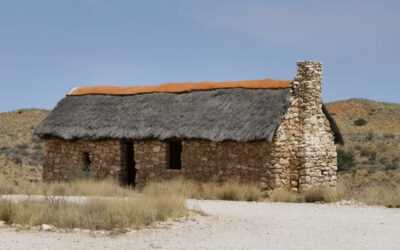
Kgalagadi Transfrontier Park 3 Days / 2 Nights

Kgalagadi Transfrontier Park 10 Days / 9 Nights

Kgalagadi Transfrontier Park 8 Days / 7 Nights

Private Kgalagadi Luxury 5 star Rooiputs & Polentswa – 6 Days / 5 Nights

4 Days Unfenced Wilderness 4 Days / 3 Nights

Witsand, Augrabies, Kgalagadi 7 Days / 6 Nights

Augrabies Falls & Kgalagadi Transfrontier Park – 4 Days / 3 Nights

Augrabies – Kgalagadi 5 Days / 4 Nights

Kgalagadi 6 Days 6 Days / 5 Nights

Kgalagadi 5 Days 5 Days / 4 Nights

Kgalagadi Transfrontier Park – Nossob 4×4 Eco Trail 6 Days / 5 Nights

Unfenced Wilderness Camping 10 Days 9 Nights

Unfenced Wilderness Camping 6 Days 5 Nights

Unfenced Wilderness Camping 3 Days / 2 Nights

Unfenced Wilderness Camping 5 Days / 4 Nights
Destinations
Kgalagadi Tours Northern Cape Tours South Africa Tours Namibia Tours Botswana Tours

Safari into South Africa
Cell. +27(0)71 160 0972 E-mail. [email protected]
www.kalaharisafaris.co.za

STAY UP TO DATE
Terms & Conditions Frequently Asked Questions

- Kgalagadi Transfrontier Park
38,000 sq. km
2000 (Transfrontier Park)
March to May
Off-the-beaten-track in Botswana and South Africa
The Kgalagadi Transfrontier Park (KTP) became a “peace park” in 2000 when the Mabuasehube-Gemsbok National Park of Botswana and the Kalahari Gemsbok National Park of South Africa merged. It is popular with repeat visitors more than with first-time safari-goers.

Things to do
- Where to stay
- Where To Go
A true adventure for nature lovers
The Kgalagadi Transfrontier Park is most rewarding to those who seek an adventure along the trails which others do not often tread on. Covering both Botswana and South Africa, the KTP is the first park in Africa to extend over two separate countries and its wildlife and remoteness leads to a deep appreciation of the Kgalagadi wilderness.
The Botswana side of the KTP is the wilder side of the two. The wilderness trails which run through this part of the park require a 4×4 vehicle and an experienced off-road driver. Lodges on the Botswana side are few and far between, as it is the unfenced and rudimentary wilderness campsites which offer the greatest appeal. The amount of people allowed per campsite is limited and requires you to be self-sufficient like a true adventurer. What you get for your efforts is great wildlife viewing and beautiful landscapes, including the red sand dunes of the Kalahari, the only place in Botswana where these can be admired.
The facilities on the South African side of the Kgalagadi Transfrontier Park are more developed, offering not only camping but also a greater variety of accommodated options. These range from self-catering to fully catered and luxury lodgings. All of this on land which was traditionally roamed by the San people (or Basarwa as they are sometimes referred to in Botswana). A visit to a local San cultural village can give you a fascinating look into their ancient way of life and you can even learn a thing or two on how to survive in this harsh climate on a guided bush walk with a local San.
The Kgalagadi Transfrontier Park is also known for providing great wildlife sightings. You won’t be able to spot the Big 5 but when it comes to predators, the region can provide memorable moments. The Kalahari black-maned lion is the most famous of the predators and this park is one of the few where these striking looking lions can be spotted. Additionally, the park boasts leopard, cheetah, brown and spotted hyena and bat-eared fox amongst its species of hunters. Further residents of the park include antelopes such as the oryx, springbok, eland, and kudu. You should also spend some time admiring the meerkats which call the KTP home as these adorable creatures have a complex and interesting social life.
Due to the remoteness of the Kgalagadi Transfrontier Park, it is often overlooked by the main tourist masses. This is the reason why those who go there, love the park. The thrill of hearing a lion roar whilst camping on one of the unfenced campsites with no other travels around might not be for the faint-hearted, but for many it encapsulates why they love going on safari. Being close to nature and close to wildlife. With pristine landscapes along the way, the KTP will provide you with a fantastic off the beaten track adventure.
Off-Road Experience
You can truly experience 4×4 rugged off-road driving on the Botswana side of the Kgalagadi Transfrontier Park. The deep sand and tough road conditions make for an adventurous journey.
Impressive Landscapes
You can marvel at the beautiful shifting red dunes of the Kgalagadi, the only place in Botswana where you can do so. This ancient land and harsh environment create a mesmerising landscape for you to discover.
A Transfrontier Peace Park
You can explore the first transfrontier, peace park in Africa. Free movement within the park allows not only the animals but also you to travel between Botswana and South Africa on a unique safari adventure.

On Kgalagadi safari tours you can experience uninterrupted and exclusive wildlife moments.

The red sand of the Kalahari Desert paints beautiful landscapes.

There are very few lodges, but you can camp on one of the remote and unfenced campsites in the wild.

An experience truly off the beaten track, for self-sufficient adventurers.
Best time to go to the Kgalagadi
The dry season brings animals to the waterholes as well as to the dry riverbeds of the Auob and Nossob. During the dry winter months, the nights can get well below freezing cold so be prepared. Summer months bring fresh rains, great wildlife viewing and spectacular birding with scorching hot temperatures. Depending on your preferences, it’s always a great time to go on Kgalagadi safari tours.
Best for more moderate daytime temperatures
Green Season
Best for wildlife sightings
An adventurous but exclusive experience
You can witness spectacular game viewing at any time of year and never will the park feel crowded with visitors. This is particularly true on the Botswana side where the number of vehicles per day allowed on the wilderness trails and campsites is restricted. It is just you and the Kgalagadi around you.

If you’re up for an adventure, the Kgalagadi is your place. However by adventure we do mean adventure – you will overnight on unfenced campsites in the wild, not meet other travellers for many days at a time and experience the true meaning of remoteness and isolation. If you are hands-on, flexible and not afraid of the dark, you will love it here!

Experience the Central Kalahari Game Reserve

Kalahari & Okavango Delta
Places Central Kalahari Game Reserve, Makgadikgadi Salt Pans, Moremi Game Reserve
Price on request (RQ)
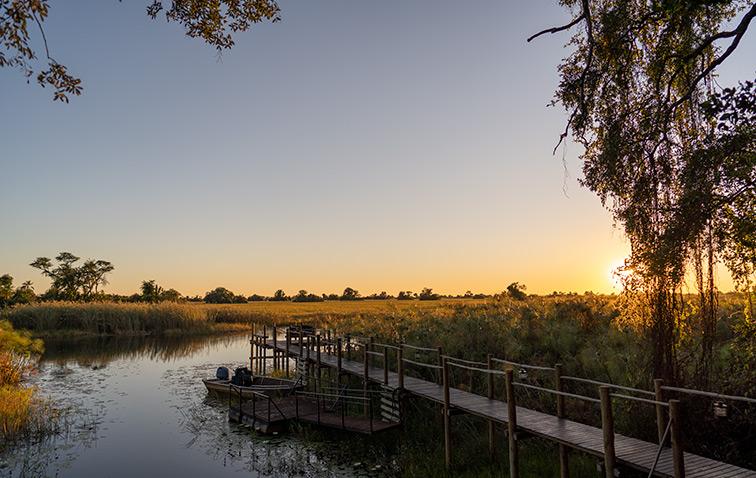
Tailor-Made Safaris in Botswana

- Classic Game Drives
Look for wildlife on guided or self-drive game drives

- Private Safaris
A safari experience tailored to your wishes

- Camping Safaris
Overnight at unfenced campsites in the wilderness
Great wildlife viewing throughout the year
Kgalagadi safari tours are a great opportunity to experience Southern Africa’s wildlife without having to share sightings with many people.

Black-Maned Lions
These rare lions roam the vastness of the Kgalagadi Transfrontier Park

The fastest land mammal on the planet can be spotted here

These curious looking large antelopes are common on the Kgalagadi plains

These fascinating suricates display very complex social behaviour
WILDLIFE IN THE KGALAGADI
A rugged and hidden wildlife gem for true africa lovers.
While wildlife watching is possible all-year-round on Kgalagadi safari tours, the best time is at the end of the wet season, when mammals come to the riverbeds to drink. You can spot lions and leopards, hyenas, oryx and meerkats.
Where to stay in the Kgalagadi

Mobile Camps
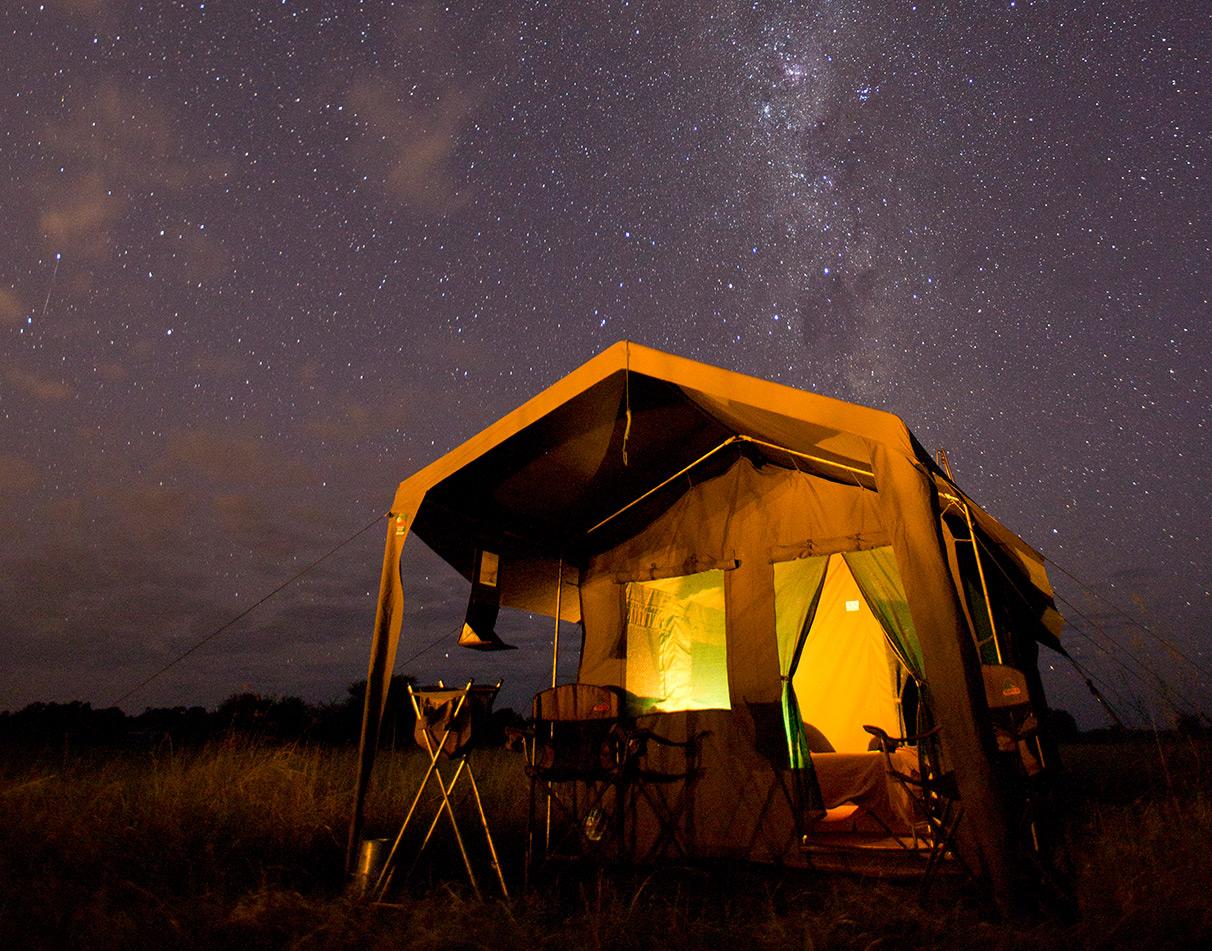
Guest Tent at Mobile Camp
The Kgalagadi Transfrontier Park is located in the very south-west of Botswana, spanning into South Africa’s Northern Cape. You can enter the park in one country and leave it from another. Most visitors enter the park via the South African side, travelling from Johannesburg to Upington. A 4×4 vehicle is essential and a convoy recommended and sometimes required.
- Kgalagadi Transfrontier Park
- Maun 750 km | 10 hours’ drive
- Ghanzi 460 km | 7 hours’ drive
- Gaborone 460 km | 8 hours’ drive
- Mata-Mata 330 km | 15-17 hours’ drive
- Twee Rivieren 330 km | 15-17 hours’ drive
- Upington 500 km | 9 hours’ drive

Experience Botswana with us
Speak to one of our local advisors, let's start planning your trip.
We will get back to you within 2 working days.

- Gallery & Travel Friends
- Testimonials
- Kimberley Day Tours
- Kgalagadi Transfrontier Park Safari
- Kalahari Safari Photography Tour
- Chobe and Savuti Leopard Safari
- Masai Mara Wildebeest Migration
- Rwanda Gorilla Safari
- Southern Africa Tour
- Kalahari Safari
You are here: Tours / Kgalagadi Transfrontier Park Safari
The Northern Cape is the biggest of the nine provinces in South Africa, covering almost a third of the total surface area of the country, with a population of less than a million people.
The wide open spaces, at least 5 national parks with easy access, beautiful red sand dunes, two of the largest rivers in SA, carpets of Spring flowers in Namaqualand, rich diamond history around Kimberley and along the West Coast, a wealth of plants and wildlife, are just some of the reasons why the Northern Cape deserves to be at the top of every traveller’s list.

- kgalagadi-transfrontier-park-4.jpg
- kgalagadi-transfrontier-park-5.jpg

Imagine exploring the “desert”, with white water rafting on the largest river in SA, game drives and bushman-guided nature walks in the first and biggest transfrontier park in Southern Africa – Kgalagadi, sand surfing on white sand dunes, a visit to one of the six biggest waterfalls in the world – Augrabies, wine tasting at the second biggest cooperative wine cellar in the world, dinners under the BIG starry skies of the Northern Cape Province!
The word Kgalagadi (Kalahari) means “land of thirst” in the Setswana language, quite literally one of the world’s oldest deserts, formed over 60 million years ago.
It is a huge semi-desert region in southern Africa stretching from South Africa, through Namibia, into Angola and comprising the entire western and central regions of Botswana.
It is also home to the Kgalagadi Transfrontier Park, a 3.7 million hectare expanse of pristine desert and a wealth of desert-adapted creatures inhabiting the dunes and plains covered in Bushman grass and Camelthorn trees. Accommodation varies from luxury lodges, en-suite chalets in the traditional fenced rest camps, secluded bush camps (unfenced), to camping.
It is characterised by red sand dunes and sparse vegetation and is home to black-maned Kalahari lion, leopard, cheetah, spotted and brown hyaena, wild dog, black-backed jackal, gemsbok (oryx), blue wildebeest (gnu), eland, springbok, red hartebeest, duiker and steenbok. Some 215 bird species have been recorded.
The Kalahari also offers sightings of animals rarely seen in other parts of Africa. These include Honeybadger, Porcupine, Aardvark, Meerkat and the occasional Pangolin.
The desert conditions offer the unique opportunity to observe animals in their natural environment, employing special adaptations for survival.
Nature is more quiet and reserved due to the open terrain, and only the bold will be daring enough to proclaim its territory out loud. It would thus not be uncommon to hear the loud echoing roar of a lion breaking the peaceful silence of the Kalahari night.
Cheetah can be seen stalking their quarry, using the very limited cover and running down their prey over the dry river bed.
A honeybadger boldly following a cape cobra into a camelthorn tree, before finally apprehending it, dropping to the ground and consume it with relish.

- kgalagadi-transfrontier-park-6.jpg
- kgalagadi-transfrontier-park-7.jpg
After the rain, a pride of lion can be seen inspecting a big puddle of water, before chasing each other through the water as if for the first time.
Kgalagadi has all the elements for dream photography: perfect light and setting, willing models, and sparse vegetation for an unobscured view and shooting angle.
The warm light of the early morning sun, gives an unmatched quality to the red dunes and surroundings. Combine that with a black-maned lion, with bright honeycomb eyes, walking into view… and hopefully you have GIGS of memory available!
The rest camps are situated along the Nossob and Auob rivers, with most tourist routes developed along the dry river beds. Other than the flowing dunes, covered by grass in summer and barren in winter, only the occasional camelthorn tree obscure the view in the wide open expanse. Camp gates open at sunrise and close at sunset, allowing for maximum photographic opportunities.

Water holes are situated at regular intervals along the Nossob and Auob rivers. It is frequented by predators and herds of plains game alike, and the proximity to the tourist routes, make each water hole an ideal vantage point for photographers. Wildebeest jostle and play near the water, while waiting for their turn to drink. Big flocks of sandgrouse approach and land against the breeze, taking two quick sips of water, before flying off in a cloud of dust. Lanner falcons stoop from high above, making spectacular strikes on the departing sandgrouse.
Though animals in this desert environment are well adapted for long periods without water to drink, sightings at the water holes are almost guaranteed.
Winter in Kgalagdi is known for cold nights, followed by crisp air and warm colours in early morning. The arc of the sun is low, allowing for longer hours of good light for photography. Winters are dry and a herd of springbok filing along the riverbed, with a trail of powdery dust creating ghostly images with the backlight of the rising sun, would be a typical appearance. Food is scarce and the herbivores have to travel long distances between their grazing and water holes. Predators often use this opportunity to stalk their prey at the water holes.
With the change of seasons, comes the wind and dust-filled skies and a beautiful spectrum of reds at sunset. This creates a dramatic effect, unmatched in our more familiar national parks.
Summers are warm to hot, with the occasional thunderstorm that fills the sky with dark clouds and sheet lightning. The nights are short and the predators are often forced to still be stalking their prey in the early morning hours. With the rain come the green vegetation and an abundance of babies, a time of easy “hunting” for predator and prey alike.
With daily flights to Upington, from Johannesburg and Cape Town, or transfers from any city in SA, it has never been this easy to visit the Kalahari region.

Sample Itineraries
OPTIONAL ADD-ON : The itinerary can start in Kimberley area, with a visit to the Diamond mine.
They can stay overnight at a lodge close to Kimberley, where they can take part in a game capture experience, and do a tour of the breeding centre for rare species
After that we can do an overnight stop in Witsand Nature Reserve, where the Roaring Dunes are, before travelling on the Kgalagadi via Upington the next day.

Arrive at Uptn airport. Depending on time for flight arrival, either overnight in Uptn, or travel to Kgalagadi directly
Assuming they arrive on the morning or mid-day, we travel to Tweerivieren from airport Check into the park, offload luggage at chalets Late afternoon game drive Dinner and overnight Tweerivieren
Coffee/tea/rusks/breakfast bars
Depart (luggage loaded) on early morning game drive
Stop around 11am for picnic brunch (yoghurt, muesli, cold meats, bread, spreads, tomato, cheese, fruit, juice, coffee/tea)
Continue game drive to Nossob Restcamp
- accommodation consists of en-suite chalets, all meals prepared by me
Late afternoon game drive
Dinner around the fire
Overnight Nossob
Early morning and late afternoon game drives, 3-4 hours per game drive
Early morning coffee/tea/rusks/breakfast bars; late morning brunch, full dinner
There will be fruit and snacks available all day
Same program, but luggage loaded, as we move to Mata Mata Restcamp
Stay 3 nights
Same program, but luggage loaded, as we move to Tweerivieren Restcamp
Stay 1 night

- kgalagadi-transfrontier-park-11.jpg
- kgalagadi-transfrontier-park-12.jpg
- kgalagadi-transfrontier-park-12a.jpg
- kgalagadi-transfrontier-park-13.jpg
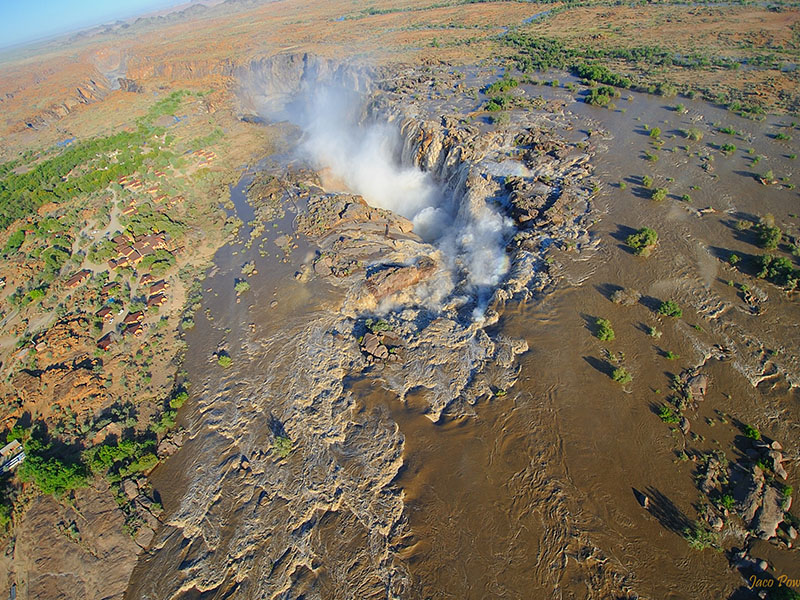
Depart for Augrabies Falls National Park
Stop at a dried fruit shop along the way
Lunch at Bezalel, with optional Brandy cellar tour
Check in at Augrabies
Late afternoon walk to the various viewpoints along the falls
Dinner at restaurant
Overnight Augrabies
Optional walks/hikes/river rafting
Game drive in Augrabies Falls Park, visit Oranjekom with spectacular view of the Orange River Gorge
Lunch, dinner in Park
On day 12, you can be transferred to the Uptn airport, OR continue to 11 Springbok to see the wild flowers
The rest of program can then include 2 nights in Springbok, to view the carpets of Namaqua Daisies, one night at Travellers Rest to see the Bushman Paintings, and drop off in Cape Town (or some days touring around Cpt)

- kgalagadi-transfrontier-park-15.jpg
- kgalagadi-transfrontier-park-16.jpg
- kgalagadi-transfrontier-park-16a.jpg
Contact Details
Cape Fox Tours & Photography
Email: [email protected] / [email protected]
Phone: +27 82 572 0065

Universal Access Company
© Copyright 2023 - Cape Fox Tours & Photography - Website by Delwedd . Privacy Policy .

Kgalagadi Tour
Join us for a tour to the Kgalagadi Transfrontier Park, a pristine wilderness that straddles the borders of South Africa and Botswana in southern Africa. This vast and awe-inspiring desert landscape spans over 3.6 million hectares and is home to a diverse range of wildlife, including lions, cheetahs, hyenas, and many other fascinating species. Whether you’re a seasoned safari-goer or a first-time adventurer, our tour company offers unforgettable experiences that will immerse you in the natural beauty and rich culture of this incredible region. Join us on a journey to discover the wonders of Kgalagadi Transfrontier Park and create memories that will last a lifetime.s now and experience the trip of a lifetime!
7 Days 6 Nights
Price per person: pricing varies depending on the type of accommodation, size of group and the season., cape heaven tours will provide a proposal based on your specific requirements., only 1 may till 30 june every year..
Arrival in Cape Town
If time allows, some sight seeing
We depart early morning to Upington, where we will spend the night after approximately 8 hours on the road. During our journey, we will make regular stops to stretch our legs and enjoy coffee and lunch.
After enjoying breakfast and a good night’s rest, we will travel the final 300km to arrive at the Kgalagadi Transfrontier Park before noon. Once we’ve checked in and had lunch, we will begin exploring the park until dinner time. After dinner, we will relax and marvel at the stunning Kalahari sunset before retiring for the following two nights in the luxurious Kgalagadi Lifestyle Lodge, just outside the park, where desert haven meets modern wilderness.
Today, we will spend the whole day in the park, trying to catch a glimpse of as many wild animals as possible.
After breakfast, we will take one last drive through the park until lunchtime. After lunch, we will hit the road back to Upington where we will spend the night.
On our last day of the Kgalagadi Transfrontier Park tour, we will make the long journey back to Cape Town, stopping regularly to stretch our legs, enjoy a cup of coffee and lunch.
Departure from Cape Town
If time allow, some sight-seeing.


How to maintain your fitness while on holiday
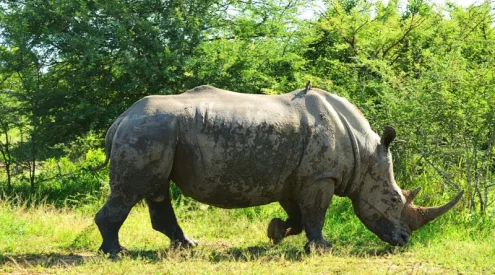
Rhino dehorning programme employed Ezemvelo KZN Wildlife for anti-poaching efforts
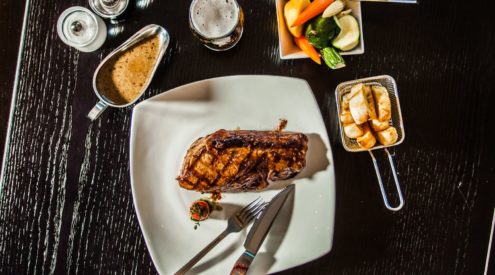
A foodie’s guide to Durban: 7 Restaurants and cafes to visit

Breakfast bliss: A guide to Jozi’s morning eateries
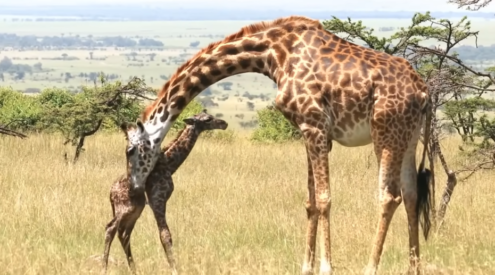
Baby giraffe takes first steps
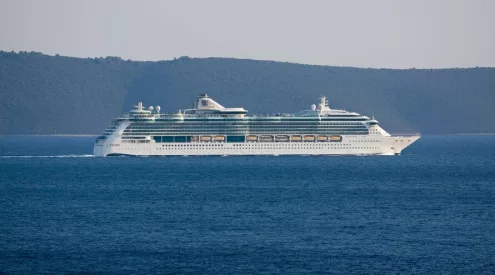
South African stabs multiple passengers on cruise ship
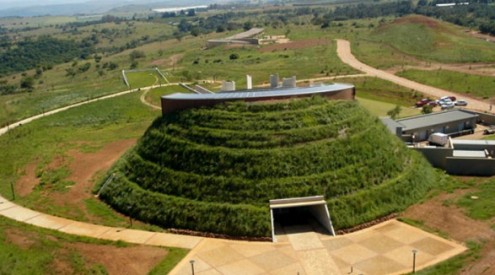
Things to do in and around the Cradle of Humankind
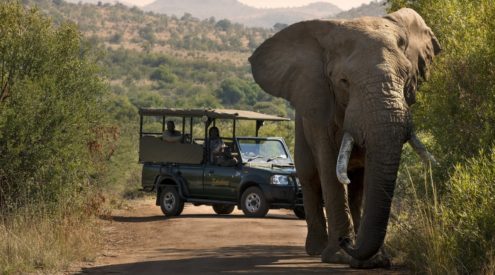
Exploring North West through the eyes of a nature lover
First-timer’s guide to the kgalagadi.
The Kgalagadi Transfrontier Park, straddling the border between South Africa and Botswana, is a semi-desert of red dunes and star-crammed skies where African animals run wild and visitors get a wilderness ‘fix’ that’s Prozac for the soul. Once Kalahari sand gets into your shoes, legend says, you’ll be drawn back again and again.
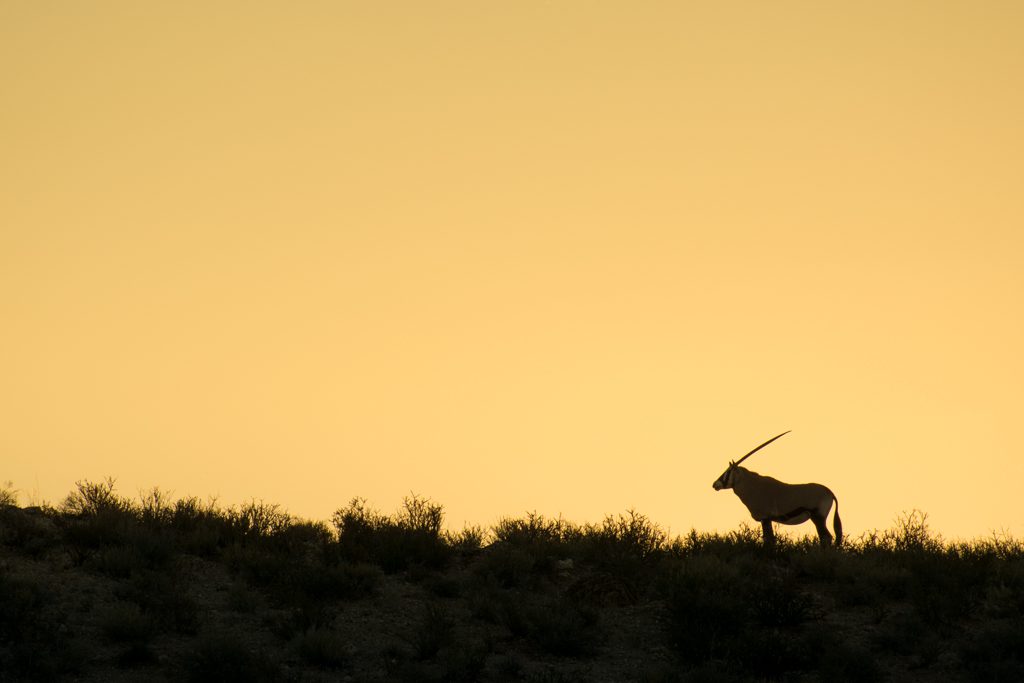
A Gemsbok stands majestically on a calcrete ridge at sunset in the Kgalagadi. Photo by Melanie van Zyl
Getting there
Take the R360 for 250 kilometres from Upington in the Northern Cape, via Askham to Twee Rivieren on the South Africa/Botswana border (total distance from Johannesburg 960 km; from Cape Town 1100 km). If time is short and your pockets deep, fly to Upington and hire a vehicle there.
Getting around
I recommend driving a vehicle with high clearance (at least 190 mm) or 4×4, especially when the roads are badly corrugated, or muddy in the rainy season (December/January to April). I’ve seen sedans make it here in the dry season (May to November), but who knows at what cost to their suspension! A 4×4 is essential for the guided and self-drive 4×4 trails on the South African side, and everywhere on the Botswana/eastern side of the park. Deflate your tyres for a softer ride (and see tip 8 below).
Best time to visit
Any time is good, depending on what you enjoy. September–November, the end of the dry season, brings animals to the waterholes and many migrant birds. January/February gives lots of action, good raptor sightings and some electric storms if you don’t mind temperatures of 45–50 ºC. If rains have been good, March may show a greener side to the park and it’s good for birding. Steer clear of June/July if you hate being cold; night-time temperatures can plummet to as low as -10 ºC although days are sunny ( read about how fauna and flora survive desert extremes here ).
What to look for
You have a good chance of spotting black-maned Kalahari lions and maybe even a leopard, but leave your Big Five notions at home: there are no elephant, rhino or buffalo here. Rather take pleasure in birds of prey, cheetah, hyena, honey badger, bat-eared fox, meerkat and small creatures like whistling rats and barking geckos.
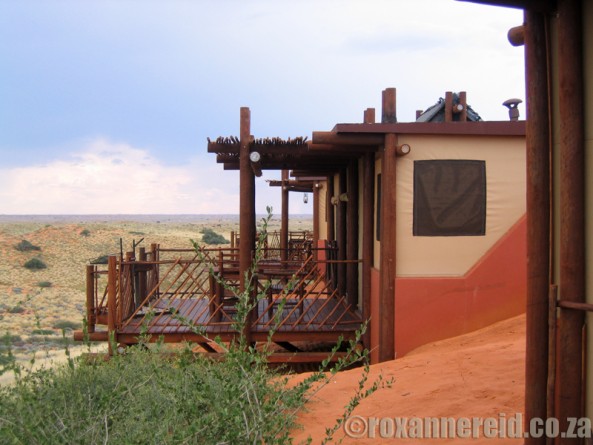
Kielie Krankie Wilderness Camp, Kgalagadi
Where to stay
South Africa : SANParks ’ tourist camps (Twee Rivieren, Nossob, Mata Mata) offer self-catering chalets and camping, while their six higher-priced and more exclusive wilderness camps (Gharagab and Bitterpan for 4x4s only) are unfenced for a close-to-nature feel. The private !Xaus Lodge on land returned to the Mier and Khomani San is a fully-catered luxury option. Kgalagadi Lodge ( read about this little piece of Paradise in the Kalahari here ) outside the park, five kilometres south of Twee Rivieren, has self-catering chalets, camping with private ablutions, and a good little restaurant.
Botswana : Botswana Department of Wildlife and National Parks (DWNP) provides unfenced bush camping with long-drop loos at Rooiputs and Polentswa, and on a range of multi-night trails across the dunes. You must have a 4×4, bring all your own water and be entirely self-sufficient. At the other end of the scale are the new full-board private lodges at Rooiputs and Polentswa .

Kgalagadi is the place to get close to amazing wildlife sightings
Tips for visiting the Kgalagadi Transfrontier Park
1. Buy the official info guide to the park at Twee Rivieren for background on the park’s animals, plants and neighbouring San communities.
2. Take warm gear if you visit in winter; use sunscreen and keep hydrated in summer.
3. Rain falls mainly between January and April, though we were once caught in a hail storm in September. The dry season is May to November/December.
4. The safety of the water is suspect. Bring drinking water from home or buy 5-litre jugs of mineral water outside the park where it’s cheaper.
5. You can buy fuel only at Twee Rivieren, Nossob and Mata Mata.
6. Only Twee Rivieren, Nossob and Mata Mata have shops selling bottled water, basic food/toiletries and firewood.
7. Budget for at least one guided early morning walk (R313 a person, no kids under 16) or sunset/night drive (R181 a person, kids half price) during your visit.
8. If you venture out on a 4×4 trail, take a grass net to protect your radiator and deflate your tyres to 1.6 bars or less so you don’t get stuck in thick sand. For safety, travel with at least two vehicles.
9. This is a transfrontier park, but if you want to leave the park in Botswana or cross into Namibia at the Mata Mata border, having entered from South Africa, you must complete immigration formalities at Twee Rivieren/Two Rivers, and stay a minimum of two nights in the park.
10. Kgalagadi is not a high-risk malaria area, but use repellents and cover up at dawn/dusk in summer.
SANParks www.sanparks.org !Xaus Lodge www.xauslodge.co.za Kgalagadi Lodge www.kgalagadi-lodge.co.za Botswana DWNP, tel +267-318-0774, email [email protected] TaShebube Rooiputs and Polentswa tashebube.com For an organised camping tour try Overlanding Africa’s nine-day package or Getaway Travel’s six-night Kgalagadi self-drive-expedition
About the blogger
Roxanne Reid has visited the Kgalagadi Transfrontier Park 30 times and is the author of ‘ Travels in the Kalahari ’.
Related Articles
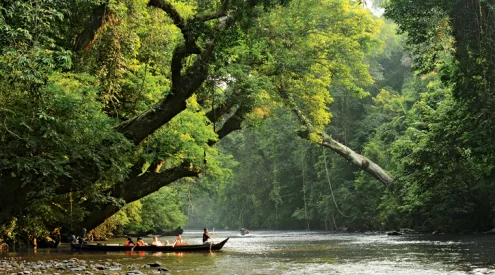
Unearthing Southeast Asia’s 5 hidden gems
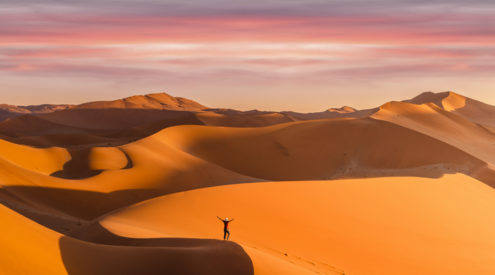
Exploring Namibia: 15 must-do activities and places to visit

5 Must try activities for active couples in the Maldives
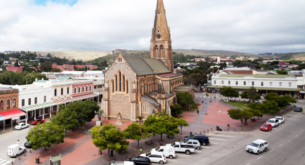
Reasons to visit Makhanda
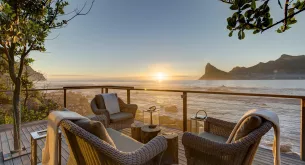
Luxury Winter Escapes at Tintswalo in Cape Town
Privacy overview.
Functional cookies help to perform certain functionalities like sharing the content of the website on social media platforms, collect feedbacks, and other third-party features.
Performance cookies are used to understand and analyze the key performance indexes of the website which helps in delivering a better user experience for the visitors.
Analytical cookies are used to understand how visitors interact with the website. These cookies help provide information on metrics the number of visitors, bounce rate, traffic source, etc.
Advertisement cookies are used to provide visitors with relevant ads and marketing campaigns. These cookies track visitors across websites and collect information to provide customized ads.
Other uncategorized cookies are those that are being analyzed and have not been classified into a category as yet.
Kgalagadi Transfrontier Park, South Africa: The Complete Guide
:max_bytes(150000):strip_icc():format(webp)/DSC00412-5b73daf7c9e77c0057ca2198.jpg)
Jessica Macdonald
- Bird Species
Things to Do
Where to stay, weather and when to go, getting there, tips for your visit, kgalagadi transfrontier park.
Established in 1999 as the first cross-border national park in Southern Africa , Kgalagadi Transfrontier Park lies partly in Botswana , and partly in South Africa . It also provides border access to and from Namibia , making it a popular destination for those on a self-drive adventure through some of the continent’s best safari destinations. Defined by the dry riverbeds, arid pans, and red sand dunes of the Kalahari Desert, Kgalagadi is one of South Africa’s great untamed wildernesses. Its challenging off-road trails make it the holy grail for 4x4 enthusiasts, while photographers are drawn by its magnificent golden light. Above all, the Kgalagadi is renowned as the best park in South Africa for predator sightings, ranging from big cats to birds of prey.
Only a third of the park is situated in South Africa. However, the South African section of the park is by far the most visited and therefore is the focus of this article. For information about the Botswanan side, visit the official Botswana tourism website .
Animals in Kgalagadi Park
Each day in Kgalagadi brings an abundance of wildlife sightings, made easy by the park’s sparse vegetation and the fact that animals tend to congregate in the dry riverbeds of the Auob and Nossob Rivers. Majestic black-maned lions are the park’s most famous residents, while usually elusive leopards and cheetahs are spotted with incredible frequency. Smaller African felines also abound, and include the caracal, the African wild cat, and the black-footed cat. You are likely to see spotted and brown hyenas, while the lucky few may catch a glimpse of the park’s endangered African wild dogs.
Water-dependent species including elephants, buffalos, and hippos are not found in Kgalagadi. However, desert-adapted herbivores like gemsbok, eland, blue wildebeest, and springbok are common, while herds of giraffe are miraculously able to sustain themselves on the park’s sparse greenery. Other Kgalagadi highlights include spiders and families of ground squirrels and meerkats, whose antics keep visitors entertained for hours; and smaller canids like the black-backed jackal and the bat-eared fox.
Bird Species in Kgalagadi Park
280 bird species have been recorded in the park, 92 of which live in the park year-round. Kgalagadi is famous for its raptors, with a cast that ranges from eagles (tawny, bateleur, and black-chested snake eagles being the most common) to owls and vultures. Keep an eye out for pint-sized pygmy falcons, and seemingly ever-present pale chanting goshawks. Non-raptor highlights include Africa’s largest flying bird, the kori bustard; and sociable weavers, whose vast nests have been known to topple fully grown acacia trees with their incredible weight.
Kgalagadi Transfrontier Park is a paradise for self-drive safari enthusiasts. Its vast expanse is traversed by a network of gravel and sand roads, some of which are designated for four-wheel-drive vehicles only. The most revered of these is the four-day Nossob 4x4 Eco Trail , which runs through the dunes between Twee Rivieren and Nossob rest camps. This route demands a minimum of two vehicles, requires visitors to be completely self-sufficient, and must be booked well in advance. The three main rest camps and Kalahari Tented Camp also offer guided morning and sunset game drives, subject to interest and the availability of staff members.
Main Rest Camps
Kgalagadi has three main rest camps, all of which offer a choice of self-catering chalets and fenced campsites. Facilities at all three include drinking water, electric power points in the campsites, laundry facilities, fuel stations, and a swimming pool. All three also have shops selling camping essentials. Twee Rivierien is the largest camp and the park’s administrative headquarters. It is located at the main gate in the far south, and is the only camp with a restaurant, 24-hour electricity, and cell reception. Mata Mata and Nossob camps are located at the Namibian and Botswanan borders respectively. Both have a waterhole with a hide, and generator-powered electricity for 16.5 hours a day. Neither have cell reception. Nossob has its own predator information center and is the most remote of the three main camps.
Wilderness Camps
There are five wilderness camps at Kgalagadi, for those that want the most authentic off-the-beaten-track experience. They are called Bitterpan, Grootkolk, Kieliekrankie, Urikaruus, and Gharagab. None of them are fenced, and there are no facilities. You must bring your own water, firewood, food, and cooking equipment. All five camps have their own waterholes, and a maximum of eight people are allowed to stay there at any one time. Children under 12 are not allowed to stay in the wilderness camps for safety reasons.
Kalahari Tented Camp
This is a luxury camp with 15 permanent desert tents. Each one has a ceiling fan, a bathroom with gas-powered hot water, a kitchen, and solar electricity. The camp has its own swimming pool and waterhole, but there is no shop or gas station. The nearest place to purchase supplies is from Mata Mata rest camp, just under 2 miles away.
!Xaus Lodge
Owned and operated by the indigenous ‡Khomani San and Mier communities, !Xaus Lodge is the only luxury lodge located within park boundaries.
The Kalahari Desert is semi-arid, with irregular rains that fall mostly during thunderstorms in the South African summer (November to April). Summers are scorching, with temperatures regularly reaching 107 degrees F (42 degrees C) in the shade. Winters (June to October) are mild and dry, although temperatures can fall well below freezing at night.
Winter is generally accepted to be the best time to go on safari . Animals gather at water sources and are easier to spot, the visibility is better for safari photos , and the roads are in better condition. Lower temperatures and humidity also make life in the desert more comfortable. Nevertheless, summer can also be a rewarding time to visit, with lush green grass and yellow desert flowers briefly transforming the park’s arid landscapes. Migratory birds also arrive at Kgalagadi in summer.
Visitors from the south and west travel to the park entrance at Twee Rivieren via the R360 from Upington in the Northern Cape. The journey takes approximately 2.5 hours on a road that’s newly tarred and in good condition. If you’re traveling from the east, you can choose to take the R31 from Kuruman via Van Zylsrus. This route takes 4.5 hours on a badly corrugated gravel road, but saves you approximately 30 minutes versus traveling via Upington.
General Advice
- Although not compulsory on the main park roads, 4x4 vehicles with high ground clearance and low range capabilities are recommended, especially in summer. In case of breakdown, keep an emergency supply of water in your car and stay in your vehicle until help arrives.
- The Twee Rivieren shop is the only one that accepts credit or debit cards, and is also the only camp with an ATM. If you’re planning to stay at the other camps, bring cash (although fuel stations throughout the park accept cards).
- Accommodation tends to fill up months in advance, so be sure to book early on the South African National Parks website .
- Kgalagadi is a low-risk malaria area—consult your doctor about whether or not you should take prophylactics.
- All foreign visitors must pay a daily conservation fee of 384 rand per adult or 192 rand per child. Discounted rates apply for South African citizens and SADC nationals.
Driving Distances
- Driving distances between the rest camps are considerable. For example, it takes 4.5 hours to drive from Twee Rivieren to Nossob, and 3.5 hours to drive from Twee Rivieren to Mata Mata (not including stops for wildlife viewing). Gharagab wilderness camp cannot be reached from Twee Rivieren in a single day.
- If you plan on arriving at the park in the afternoon or have to leave early in the morning, be sure to stay at the camp closest to your entry or exit point. Make sure to check gate and border post times carefully.
- No driving is allowed in the park after dark.
Border Crossings
- If you want to enter the park from South Africa and exit into either Namibia or Botswana, you must complete immigration paperwork at Twee Rivieren and stay in the park for a minimum of two nights.
- To cross into Namibia, your vehicle must have a ZA sticker. Namibian immigration charges a road levy for vehicles and trailers (242 rand and 154 rand respectively at the time of writing).
Top 5 Self-Drive Safari Destinations in Southern Africa
Karoo National Park: The Complete Guide
Okavango Delta, Botswana: The Complete Guide
10 of the Best Private Game Reserves in South Africa
10 of the Best Places to Visit in Botswana
Addo Elephant National Park: The Complete Guide
The Top 12 National Parks to Visit in Africa
Road-Tripping Through South Africa’s National Parks with a Toddler
Kruger National Park: The Complete Guide
Namaqua National Park: The Complete Guide
The Top 5 Places to See Elephants in Africa
Golden Gate Highlands National Park: The Complete Guide
Malaria Free Safaris in Africa
Etosha National Park: The Complete Guide
Hluhluwe-Imfolozi Park, South Africa: The Complete Guide
South Luangwa National Park, Zambia: The Complete Guide

6 Day Kgalagadi Camping Safari
The Kgalagadi Camping Safari is the perfect way to explore the Kgalagadi Transfrontier Park. This safari will start and end in Upington. Upington is the Town of the North in the Northern Cape. The vast open land and the arid environment allow for a unique Kgalagadi Transfrontier Park experience. The Kgalagadi is well known for its immense semi-desert landscapes and striking red dunes.
Kgalagadi is a great colossal land that covers 38000 km 2 . The landmass resulted from an amalgamation of the Kalahari Gemsbok National Park in South Africa and the Gemsbok National Park in Botswana. There are two of the three Kalahari ecotypes in this region. The southwestern part comprises dune veld with unique semi-desert vegetation. The northeastern part consists of the Kalahari thornveld. Salt pans are a mineral sentence for the animals. It is common to see Gemsbok antelopes licking the mineral salts.
Kgalagadi Camping Safari inside the Kgalagadi Transfrontier Park
Kgalagadi Transfrontier Park has two dry river beds. The Nossob and the Auob river beds. These are mainly dry river beds with an underground water source. Our game drives are along these riverbeds as most animals visit these areas for their first food and water source. It is not uncommon to find the predators lurking along these riverbeds to complete a successful hunt.
The river beds connect with two dune roads. These River Beds make an ideal game drive route between the dunes and often have predators crossing over the dune belt to reach the river beds. Our Kgalagadi Camping Safari will be early morning departures and late afternoon game drives. Every traveller will have a window seat.
We enjoy preparing meals open fires, whilst catering for any special dietary requirements, and we believe in whole meals. It is best to make your reservations well in advance. Our visit to the Kalahari comes to an end at a slow pace. We take a leisurely pace on our safaris. Join our team this season on a Kgalagadi Camping Safari.
Kgalagadi Camping Safari Highlights
- Experience Excellent Birdlife in the Park.
- Great waterholes.
- Vast dune landscapes.
- Game drives along the riverbeds.
- Open fires in the evenings.
- You can enjoy freshly be made meals on open fires.
- Unpolluted Night Skies.
The Camping Sites is subject to availability inside the park.
Kgalagadi Lodge Safari

- Guided safari vehicle.
- All park entrance fees and conservation fees.
- All game drives in the park.
- Two man dome tents and stretcher beds.
- Mattresses and sleeping bags with pillows.
- Meals & Mineral water
- Lodge accommodation day 5

- Travel fees to departure point
- Camera and chargers
- Batteries and Flashlights
- Own drinks with meals
- Own travel insurance

tour INFORMATION

tour SCHEDULE
DISCLAIMER: We reserve the right to cancel any activity due to weather or unsafe conditions. An alternative activity will be provided wherever possible.

Where do I begin, We have been around the block, Expensive Holidays – etc etc,, But let me tell you this was one of our Best Best tri …
brand ambassador

YOU MAY ALSO LIKE

3 Day Chobe Camping Safari

5 Day Chobe Camping Safari Adventure

Orange River Kayaking

6-Day Orange River Rafting

Green Kalahari Experience

Half-Day Orange River Rafting

14 Day Kalahari Crossing Safari

Kalahari Okavango Safari

RECOMMENDED ACCOMMODATION
The growcery camp richtersveld.

CONNECT WITH US
~ ask us a question ~, thank you for your interest.

BOOKING REQUEST FOR
Hello world
Our website uses Cookies for a premium user experience and for statistics tracking

- Community Projects
- Tourism Offices
- Star Grading System
- Eco - Tourism Certification Application Process
- At A Glance
- Arts and Crafts
- Local Events
- International Events
- Publications
Kgalagadi Transfrontier Park

In 1999, Botswana and South Africa signed a historic treaty, forming the first transfrontier conservation area (TFCA, or Peace Park) in Africa. Conservation experts proposed plans for the joint management and integration of South Africa's Kalahari Gemsbok National Park and Botswana's Gemsbok National Park as early as 1989. However, the parties could not fully realise these plans until South Africa came under democratic rule. Following South Africa's independence in 1994, and with the support and encouragement of the Peace Parks Foundation, negotiations were finalised with the Kgalagadi Transfrontier Park (KTP) officially opening in May 2002.
This immense wilderness (37,000 sq km) is now shared and jointly managed by both countries as a protected area. The entire park is completely unfenced, allowing wildlife to move freely along ancient migration routes that enable survival in the harsh desert environment.
Situated in Botswana's extreme southwest corner and adjacent to South Africa's Northern Cape Province, the KTP is managed as a single ecological unit, and gate receipts are shared. Tourist facilities, however, are still run autonomously.
Immigration and customs arrangements allow travellers to enter the park in one country and depart in the other. The main entry and departure point between the two countries are at the Two Rivers/ Twee Rivieren Gate, which also has camping facilities, chalets, shops and a restaurant.
The national boundary with South Africa runs along the dry Nossob River bed, with three-quarters of the KTP area within Botswana borders. Currently, KTP is visited by self-drive campers, with a few operators offering mobile tours.
There are three main areas to explore: the Nossob River valley, along the South Africa/Botswana border; the wilderness trails on the Botswana side, and what was once the Mabuasehube Game Reserve, now incorporated into KTP at its most northeastern reaches.
The Government of Botswana has allocated five fixed lodge sites for development by the private sector. To maintain the KTP's pure wilderness experience, authorities strictly control the number of vehicles that travel the wilderness trails, the number of nights a camping party can stay at a campsite (usually limited to one night) the number of people at each camp. Hence, booking well in advance is essential.
Self-drive campers must travel in a convoy of a minimum of two vehicles, and the rough and sandy roads mean that intrepid explorers use well-equipped 4x4 vehicles only.
KTP's stunning terrain includes fossil river valleys dotted with dwarf trees and bushes, grasslands and dunes of many colours. Wildlife is abundant, and the animals are attracted to waterholes along the otherwise dry riverbed.
The KTP is home to several antelope species, including the ubiquitous springbok and gemsbok, hartebeest, eland, and the famous black-maned Kalahari lion, jackal, brown hyena, and wild cats.
Rich birding is always part of the experience. Over 170 species of birds are present here, and it is not uncommon to see over 30 bird species within a few kilometres of the campsite.
At Mabuasehube, the terrain is a mixture of typical Kgalagadi tree and shrub savanna with patches of open grass savanna.
This area of KTP comprises a series of huge pans, which are the principal focus of the reserve. Campsites dot the various pans, and many are situated on slight promontories, giving almost unimpeded vision, thus making for good game viewing right from your camp-side chair.
Three of the largest pans lie along the main road; Bosobogolo, Mpayathutlwa and Mabuasehube. Others, such as Leshologago, Khiding and the fossil valley complex called Monamodi, are linked to the larger pans by sand tracks.
Each pan is unique. The Mabuasehube pan floor is bare clay rich in salts, which attracts animals that come to lick the surface, deriving essential minerals. The base of Bosobogolo pan is short, shrubby grassland, which antelope frequent to graze, accompanied, of course, by predators.
Mabuasehube is home to many main predators, including the Kalahari black-maned lion, cheetah, leopard, brown hyena, bat-eared fox, lynx, and silver fox. Like the Cape fox, sharp-eyed visitors can view small mammals such as aardwolf and black-footed cat in the pans in the evening.
Activity highlights in KTP include the following:
- Kgalagadi Transfrontier Park & Tsabong Ecotourism Camel Park
- Wilderness drives
- Mobile camping
- Sand Dune climbing
- Sand boarding
- Quad biking

Our Partners

- Travel Info

IMAGES
VIDEO
COMMENTS
Tour 11: 6 Day Kgalagadi - Polentswa Wilderness 4×4 Trail. Sandy Trail. The circular Polentswa Wilderness 4×4 Trail runs through the Botswana part of the Kgalagadi Transfrontier Park and is a true Kalahari Wilderness experience with absolute privacy. Malaria free area. Accommodation: Camping only. Tour options: Guided 4×4 self-drive convoy ...
The park also offers visitors the opportunity to experience the Kalahari Desert in its natural state, with its vast open spaces, red sand. When. The best time to visit Kgalagadi Transfrontier National Park is during the dry season, which runs from May to October. During this time, the temperatures are milder and the wildlife is more active.
Share this tour. For More Informations +27834700888 or +27117825416 Mon - Sat 8.00 - 18.00. On request ... The 3.7 million hectare Kgalagadi Transfrontier Park in South Africa & Botswana is one of the world's largest conservation areas and is a sanctuary to herds of gemsbok, springbok, blue wildebeest, eland, red hartebeest, as well as the ...
Parks and game reserves Central Kalahari Game Reserve Chobe National Park Kgalagadi Transfrontier Park Kwando, ... Kgalagadi safari tour packages Planning an African safari doesn't have to be daunting. From big five tours to honeymoon safari and beach holidays, you can find a tour here to get your started. Use the filters to narrow your search ...
E-mail: [email protected]. Web: sanparks.org. Kgalagadi Transfrontier Park phone: 054-561-2000. To make reservations at the lodges on the Botswana side ( Rooiputs lodge and Polentswa lodge ) you can book them through the Tashebube website.
Traveling to Kgalagadi Transfrontier Park? Use our FREE travel guide and safari reviews to learn about Kgalagadi's wildlife, best time to visit, climate and more! Menu. Safaris & Tours. ... Safari Tours to Kgalagadi TP. 8-Day Kalahari Self-Drive Budget Camping Tour. $434 to $542 pp (USD)
Kgalagadi Transfrontier Park - Nossob 4×4 Eco Trail 6 Days / 5 Nights . Tour M Unfenced Wilderness Camping 10 Days 9 Nights ... Unfenced Wilderness Camping 5 Days / 4 Nights. Destinations. Kgalagadi Tours Northern Cape Tours South Africa Tours Namibia Tours Botswana Tours. Contact us. Safari into South Africa. Cell. +27(0)71 160 0972 E-mail ...
The Kgalagadi Transfrontier Park (KTP) became a "peace park" in 2000 when the Mabuasehube-Gemsbok National Park of Botswana and the Kalahari Gemsbok National Park of South Africa merged. ... While wildlife watching is possible all-year-round on Kgalagadi safari tours, the best time is at the end of the wet season, when mammals come to the ...
Imagine exploring the "desert", with white water rafting on the largest river in SA, game drives and bushman-guided nature walks in the first and biggest transfrontier park in Southern Africa - Kgalagadi, sand surfing on white sand dunes, a visit to one of the six biggest waterfalls in the world - Augrabies, wine tasting at the second biggest cooperative wine cellar in the world ...
Kgalagadi Transfrontier Park. We explore the Kgalagadi Transfrontier Park and visit some of the popular watering holes that the park has to offer. Lodge Accommodation Breakfast, Lunch, and Dinner: Day 6: Kgalagadi Lodge - Upington. Our final destination is a transfer back from the Kgalagadi towards Upington. Tour ends on arrival. However ...
Join us for a tour to the Kgalagadi Transfrontier Park, a pristine wilderness that straddles the borders of South Africa and Botswana in southern Africa. This vast and awe-inspiring desert landscape spans over 3.6 million hectares and is home to a diverse range of wildlife, including lions, cheetahs, hyenas, and many other fascinating species.
For an organised camping tour try Overlanding Africa's nine-day package or Getaway Travel's six-night Kgalagadi self-drive-expedition . About the blogger . Roxanne Reid has visited the Kgalagadi Transfrontier Park 30 times and is the author of 'Travels in the Kalahari'.
Address. Botswana. Phone +267 391 3111. Web Visit website. Established in 1999 as the first cross-border national park in Southern Africa, Kgalagadi Transfrontier Park lies partly in Botswana, and partly in South Africa. It also provides border access to and from Namibia, making it a popular destination for those on a self-drive adventure ...
Kgalagadi Transfrontier Park is in the north of South Africa, on the border with Namibia and Botswana and Twee Rivieren Gate is about 1076km from Cape Town (about 11 hours) and 950km (about 10 hours) from Johannesburg. This gate will give you access to the south side of the park and is often used as the first or last stop when visiting ...
Gharagab. Garagab campsite is located in the far northern region of the park, with elevated views of Kalahari dunes and the thornveld savannah. The campsite is located 164 km, about four hours drive, north of Nossob on the road to Unions End. Garagab camp can only be reached by 4×4 vehicles. Kalahari Tented Camp.
The Kgalagadi is well known for its immense semi-desert landscapes and striking red dunes. Kgalagadi is a great colossal land that covers 38000 km 2. The landmass resulted from an amalgamation of the Kalahari Gemsbok National Park in South Africa and the Gemsbok National Park in Botswana. There are two of the three Kalahari ecotypes in this region.
Activity highlights in KTP include the following: Kgalagadi Transfrontier Park & Tsabong Ecotourism Camel Park. Wilderness drives. Mobile camping. Sand Dune climbing. Sand boarding. Camel ride. Quad biking. In 1999, Botswana and South Africa signed a historic treaty, forming the first transfrontier conservation area (TFCA, or Peace Park) in Africa.
Media Release: Border Posts Reopen in Kgalagadi Transfrontier Park. As of Monday, 1 August 2022 the following border posts within Kgalagadi Transfrontier Park (South Africa) have been re-opened: Twee Rivieren (RSA) 07h... 23 March 2021. Update of Compulsory Briefing Session date for bid GNP-012-20, in Kgalagadi Transfrontier Park